- Joined
- Sep 9, 2016
- Messages
- 22
- Reaction score
- 5
- Points
- 3
- Age
- 39
Well, I was requested to make a topic on pinball. I take it that some of you guys have been to arcades to play fighting games, and no doubt at least one of them has had a pinball machine or two (or more) sitting somewhere. Well, pinball still exists both as a hobby and as an industry. But before we begin, we'll need to go over some basic terms. For these, I have split them into six categories: Objects, Paths, Techniques, Rules, History, and Competitions. These, I believe, are in order of ease of understanding, and being familiar with one of these categories will help with understanding the ones after them. I’ve also ordered the definitions in such a way to create a progression from the most fundamental to definitions that might require knowledge of other terms to understand. If you have any questions at all, please ask. Pinball is something that’s quite obtuse and unintuitive for someone not used to it, and I’m always trying to find ways to make pinball more easily understood. Get ready to read for a while...or get bored along the way. This is well over 100,000 characters in length.
Overall, pinball terminology is amazingly straightforward, with very few terms taken from memes, references to players and incidents, or terms taken from specific games. This is likely due to pinball having been around before terms as references became popular, and most of these terms I'll tell you have been around since at least the 1950's (though they didn't all yet solidify as universal terms), with the exception of the Mechanics category.
(Bear in mind that I am referring to physical pinball machines here. There are plenty of virtual ones out there that don’t necessarily follow the same rules.)
Objects
By "Objects," I'm referring to the physical parts of a pinball machine. To keep things simple, I'll only talk about objects visible to the player or otherwise directly relevant to gameplay. These terms are in order of importance to pinball. That is, the closer they are to the top, the harder it is to talk about pinball without knowing these terms, the exception being groups of related terms (because I put them together). I'll also provide a picture of each of these objects to give a clearer idea of what they are.
Playfield - The big board containing all the devices listed in this section. With a few exceptions, an entire game of pinball will be set on this playfield and the objects attached to it. Playfield surfaces are made of layered wood, with the exception of New Canasta, which is made of PVC plastic, though things attached to the playfield can be made of anything (most commonly plastic and metal).
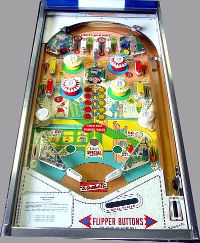
A playfield of Cross Town (photographed by Raphael Lankar)
Ball (object) - The metal ball. I'm sure you already knew what this is called. A standard ball is 1 inch in diameter and is made out of an alloy containing 90% iron and 10% chromium to minimize rusting, dulling, and wear.
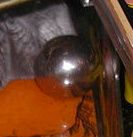
A ball in action in Congo. Keep your eye on the ball! (Photographed by Al Kuester)
Flipper - A small plastic bat, used to propel the ball upwards when swung. Flippers are under direct player control and, in most pinball machines, the only thing under direct player control. Ever since the 1950's, it has been standard to have at least two flippers, placed near the bottom of the playfield and facing each other with a gap in between. Some machines have 3 or more flippers. Two buttons are located on the sides of a pinball machine near the front corners, one on each side. The button on the left, when pushed, swings all flippers whose pivots are on the left, and the button on the right does the same for all flippers whose pivots are on the right. Flippers are also lined with rubber so the ball is bouncier when it hits a flipper.
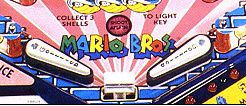
The bottom flippers in Super Mario Bros. Gottlieb liked to puts its logo on its machines’ flippers. (Promotional image from Gottlieb)
Lightning Flipper – A special type of flipper that’s yellow and has a picture of a lightning bolt on it. Lightning flippers are 1/8” (3 millimeters) shorter than a standard flipper. Some games come pre-installed with lightning flippers, but more commonly, lightning flippers are used as a replacement for a pinball machine’s normal flippers to increase its difficulty. It might not sound like much, but pinball machines were designed with the standard 2-inch flipper length in mind, and even a novice will notice the game being harder.

Both lightning flippers from Fish Tales. Notice the lightning bolt design on them. (Photographed by Billy van der ven)
Plunger - A spring-loaded metal rod with a rubber tip installed onto the bottom-right of a pinball machine. You pull the handle back and let go, and the rod will snap back, sending the ball rolling. Balls begin on the plunger, and you launch it into the game whenever you're ready to start playing.

The plunger in Torpedo Alley. Pull that thing back and start the game! (Photographed by Ken Fitzhenry)
Autoplunger - A button-based plunger. Instead of pulling it back manually, you just push the button and it launches the ball. Autoplungers are also used in games that, during certain circumstances, automatically launch a ball without input from the player. Hence, some games have both a manual plunger and an autoplunger. Autoplungers are most commonly a big button where a plunger handle would normally be, but they can take different shapes, such as the handle of a gun as seen below.
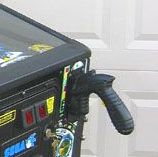
An autoplunger shaped like a gun from Batman Forever. You pull the trigger to launch the ball. Apparently, SEGA wasn't concerned with how Batman doesn't actually use guns. (Photographed by Allen Shope)
Insert, Light, or Lamp - A light placed underneath the playfield, with colored clear plastic overhead to create a flush surface where you can see the light below. These were once incandescent lights, but LEDs are an industry standard now. Inserts are used to indicate things to the player, alerting the player to certain game states depending on if the light is off, is on continuously, or blinking. All pinball machines made after World War II have inserts, and usually a lot of them. Even primitive electromechanicals (see "History" below) will have dozens of these lights scattered all over the playfield.
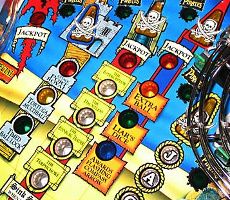
A bunch of inserts in Pirates of the Caribbean. Notice that some of them are labeled directly onto the plastic, while others have their labels to the side. For now, don’t worry about what all these mean. Just know that they’re alerting the player to certain things. (Photographed by Martin Ayub)
Coin Mechanism (commonly abbreviated as Coin Mech) or Coin Acceptor: The device at the front of the machine that takes coins. Some modern ones take dollar bills, and some operators install a card reader in its place.

A coin mech from Cyclone (Anonymous)
Switch – A device used to indicate a ball has reached or passed a particular location. If it can detect the ball’s location, or its activation means the ball has been there, it’s a switch, regardless of what it physically is. Any detection of the ball at a switch’s location is a ”switch hit.” The following 13 definitions are all either types of switches or contain switches inside of them. Hence, this paragraph has no picture because it’ll be covered entirely through the following definitions’ pictures.
Rollover – A type of switch that activates as the ball rolls over it, hence the name. Most rollover switches take the form of a slit in the playfield with a thin metal rod curved like an arc sticking out of it. Both ends are beneath the playfield, allowing the rollover to be activated from either side. When the ball rolls over the slit, it presses down on the metal arc, completing a circuit and signaling the machine that the ball has been there. Rollovers are the most common type of switch to detect a ball traveling down a narrow path. There have been a few experimental alternatives that are completely invisible to the player, such as the magnetic induction rollover, but they haven’t been standardized.
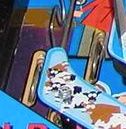
A pair of rollovers in South Park (the slits) (photograph by Christopher Wolf)
Star Rollover or Button Rollover – A special type of rollover switch that’s disk-shaped. It has many sloped lines radiating down from the center, which is what gives it its name. Whereas regular rollovers can only be activated if the ball is traveling in a specific line, star rollovers can be activated from any angle. These are used in wide open spaces, but they are more expensive to make, can’t fit in those narrow paths regular rollovers are for, and there has never been much purpose to putting switches out in the open, so they’re rare. Some types are simply a raised circle with no radiating lines; these are button rollovers. (Another reason why they’re rare is because Williams Electronics had a patent on them that only recently expired.)
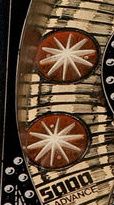
Two star rollovers from Centaur. These are used in place of rollovers, in this case because they can be placed closer together. By registering the order of activation, the game can determine whether the ball has traveled up or down this path. (Photographed by Mark Steinman)
Rollunder – A type of switch that, as you might have guessed, activates when the ball rolls under it. Also found in narrow paths, rollunders take the form of an arch over the path with a U-shaped thin metal rod hanging down that can swing. When the ball passes underneath, the metal rod will swing back, completing a circuit and, like rollovers, signaling the machine that the ball has been there. Rollunders are mostly used in raised areas and/or surfaces not made of wood, where a rollover would be difficult or impossible to install.

A rollunder switch in The Walking Dead (photograph by Martin Ayub)
Opto-Sensor or Opto Switch (usually shortened to just Opto) – A laser, invisible to the naked eye, that detects when something interrupts the beam’s path when something crosses it. In almost all cases, that'd be the ball. Optos are used in place of rollovers or rollunders where the other switches are impractical or impossible, such as crossing a wide area or a lack of overhead space.
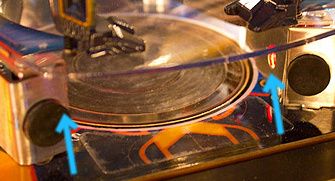
An opto system in TRON: Legacy. See the glowing hole in the wall that the right arrow is pointing to? There's a corresponding hole on the other side, which the left arrow points to, with an invisible laser running between them. Whenever the ball passes through, it blocks the laser, and the game knows the ball has gone by. (Photographed by Martin Ayub)
Pop Bumper, Jet Bumper, Thumper Bumper, or Active Bumper – A mushroom-shaped mechanism that, once the ball comes close, propels the ball away at a high speed. Probably one of the most famous objects on a pinball machine and is known simply as a “bumper” to laypeople. A pop bumper has a metal ring directly underneath its cap. When the ball touches it, it becomes slightly slanted, triggering a leaf switch below. The leaf switch signals the metal ring to slam downwards, pushing the ball away, then reset to its original position as quickly as possible in case the ball returns there. Pop bumpers are rarely found alone and are most often found in groups of 3 in an equilateral triangle. The reason why this device goes by so many names is because each major manufacturer trademarked a name for them. The company presently known as Stern claimed “pop bumper,” Bally-Williams collectively owned “jet bumper” or “jet,” and Gottlieb took “thumper bumper.” “Active bumper” is a generic term, though rarely used nowadays. It differentiates itself from the passive bumper, which does not propel the ball outwards.
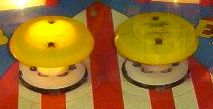
A pair of pop bumpers from Liberty Bell. Yes, they can be lit too, usually indicating they’re worth more points. (Photographed by Frank Sansone)
Slingshot – A device that detects the ball touching an outstretched line of rubber that then propels the ball away from it with a horizontally-moving solenoid. Its effect on the ball is similar to that of pop bumpers, except a slingshot’s boundary is a straight line whereas a pop bumper’s is a circle. Slingshots are sometimes found at the perimeter of a playfield, used to create wild and unpredictable ball paths, but about 95% of the time, a pinball machine will have only two slingshots, located directly above the flippers and taking the form of a scalene triangle.
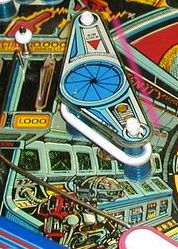
A slingshot from Xenon. Notice the flipper directly below. The pink line I’ve added in indicates the only reactive side of these triangular slingshots—that is, the slingshot will only propel the ball if the ball touches that side. (Photographed by Christopher Wolf)
Scoop – A hole that the ball can fall into. It can be deep enough to completely conceal the ball, or it can be shallow enough for the ball to simply sit in. The shallow ones are sometimes referred to as saucers. After a short time, the ball will be ejected out of the scoop and returned to the player, though in some cases the ball remains there and the player is given another ball. Scoops always contain a switch, obviously, so that the game knows the ball has fallen into it.
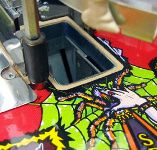
A scoop in Scared Stiff (Photographed by Allen Shope)

A saucer in Ghostbusters. It’s shallower than the ball but has a small hole in the middle for the ball to rest safely on. If you look carefully, you can also see some metal in that hole. That’s the solenoid to get the ball back out.
Trap Door – A type of scoop with a flat top that’s normally level with the playfield, allowing the ball to roll over it. When conditions are met, however, it will lift up, revealing a hole the ball can fall into.

It does look like a trap door in Theatre of Magic. When it opens up though, it doesn’t stay open for very long. (Photographed by Christopher Wolf)
Spinner – A small piece of metal or plastic, usually square, lifted slightly above the playfield. This piece is attached through the sides with a metal wire, about the thickness of a paper clip. When the ball passes by, it strikes the bottom of the piece, causing it to spin. Each full rotation of the spinner counts as a switch hit. The idea behind a spinner is that the faster and more cleanly the ball passes through, the more full rotations the spinner will do and thus the player is rewarded more for it. Spinners can be adjusted to spin for a longer or shorter time.
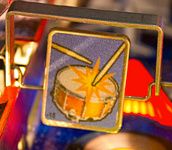
A spinner from The Rolling Stones (Stern) (Photographed by Martin Ayub)
Stand-Up Target – A piece of flat plastic, perpendicular to the playfield, with a leaf switch behind it. When the ball hits it, the impact sends the plastic piece back slightly, completing a circuit and detecting that hit. They are called stand-up targets because, of course, they’re standing up…
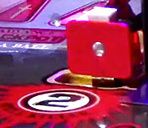
A stand-up target from Rob Zombie’s Spookshow International (Photographed by Martin Ayub)
Drop Target - …As opposed to a drop target, which drops when hit. When the ball hits it, it will drop until it’s flush with the playfield, effectively removing it from play and allowing the ball to pass through until the drop target is raised back up to its original position. How long the drop target remains down depends on the rules. Drop targets were actually invented before the stand-up target and were used in the same way stand-up targets are now, but with stand-up targets becoming more common and less expensive, drop targets were then used to block the way.
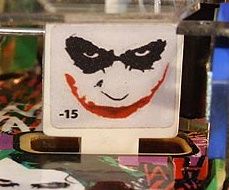
A drop target in Batman: The Dark Knight, decorated with the face of the movie’s most iconic character (Photographed by Martin Ayub)
Target Bank – A set of 2 or more stand-up targets or drop targets placed next to each other in a row. Most of the time, they are placed side-by-side, but there are a few cases of drop targets placed behind each other, resembling dominoes. These are also known as target banks.

Two banks of 3 stand-up targets each, placed side by side along a wall in Junk Yard. Each bank is next to a fourth but separate stand-up target. (Photograph by Allen Shope)

A bank of 3 back-to-back drop targets in Metallica. The one at the front is down, and the two in the back are still standing. (Photograph by Jean-Pierre Renault)
Motorized Bank – A bank of targets connected together by a motor. When all of them are hit, the motor lowers the targets down simultaneously until they’re level with the playfield, allowing the ball to pass on through.
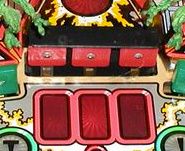
A motorized bank from Attack from Mars. Once all three of the red targets have been hit, they will all lower together. The red inserts in front of them tell you which ones you’ve hit. (Anonymous)
Captive Ball, or rarely, Newton Ball – A special kind of stand-up target, this is a ball trapped in a small, narrow path. The ball never leaves this path, even when the machine is not being played (except when moving the machine around). The path has a small opening at the bottom, not wide enough to let the ball through but wide enough for your ball to hit it. At the end of this path is a stand-up target—like with a spinner, you are supposed to hit the captive ball hard and clean enough for it to reach the target at the end of its path. Naturally, the longer the captive ball’s path, the harder and more cleanly you have to hit it. Some captive ball paths have rollover switched behind them too so the machine can measure rough distances the captive ball has traveled if it doesn’t reach the end. And while the image here is a straight line, some captive ball paths are curved, and a few even loop around themselves.

A captive ball in Fireball. Hit that ball with your own ball as hard as you can, with enough force to hit the stand-up target at the very back! (Photographed by Matty Kluge)
Gate – A mechanism that resembles a rollunder switch, but it’s not a switch. Rather, a gate allows a ball to pass through in only one direction. If the ball tries to go through the wrong way, the gate will bounce the ball away.

A gate from The Simpsons Pinball Party. The arrow I added in indicates the direction the gate will allow the ball to travel. (Not over the metal wires though.) This gate is sometimes absent though. (Photographed by Marc Alexander)
Lock or Ball Lock – A place or device that stores a ball to be released later. In most cases, certain conditions must be met for the lock to store the ball; otherwise, it will reject the ball as soon as the ball enters it. Physical locks come in two types. One uses scoops and will hold a ball there, and the other has something get in the way of the ball’s trajectory, keeping it there. There is a third type called a “virtual lock,” which I have categorized under “Rules” as it has no physical form.

A scoop-type ball lock in Capersville, with a ball stored on both locks (Photographed by Christian Jacobs)
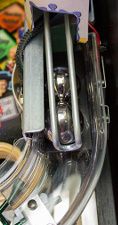
A queue-type ball lock in The Wizard of Oz, with two balls held here by the metal bars. When they’re ready, the metal bars will lift, releasing the balls. (Photographed by Martin Ayub)
Jail – A special kind of captive ball whose concept is combined with the lock. When a game begins, the jail is empty. If you send a ball in there, however, bars come down (or up, depending on the game), trapping the ball in there. Once there, the ball functions as a captive ball. This ball will be released later, either when you trigger the bars to come down or the game ends, whichever comes first.
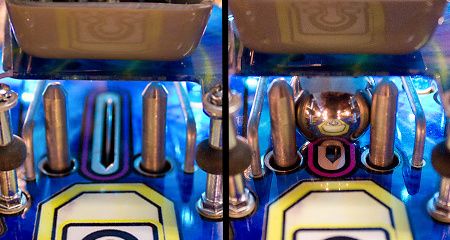
The “Link” jail in James Cameron’s Avatar. On the left is the empty jail, and on the right is the same jail with a ball trapped in it. (Photographed by Martin Ayub)
Outlane Post – A metal peg, usually but not always with a rubber ring around it, placed at the entrance to the outlane. Modern machines have easily-removable outlane posts and multiple holes to insert them in, which is a simple way of adjusting a machine’s difficulty. With enough experience, you can judge an operator’s intent by looking at where he or she has placed an outlane post. I will explain the outlane post’s purpose in more detail below in the definition for “outlane.”
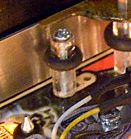
An outlane post on Big Buck Hunter Pro, set to its bottom-most position (Photograph by Mike Nogle)
Kickback or Laser Kick – A solenoid found at the bottom-left corner (rarely the bottom-right, as it’s difficult to fit it there). If the ball exits play and passes through this corner, the kickback will send the ball back up and allow you to continue playing. As you might figure, kickbacks are not always active. The word “kickback” was trademarked by Williams when referring to this mechanism. As a result, Data East, the only other company at the time to use them, called it the “Laser Kick.”

The kickback, known here as a Laser Kick, on The Adventures of Rocky and Bullwinkle and Friends. Not visible is that the image depicts a rocket blasting off, upwards and to the right. (Anonymous)
Diverter – A device located at a split in a path that decides which path the ball will take. In The Shadow, diverters are under direct player control, but on all other games, diverters will act automatically according to the game’s rules. Some diverters are long, thin sheets that act as walls that can lift or lower, and some diverters are plastic pegs that stop the ball’s momentum, causing it to drop down elsewhere.
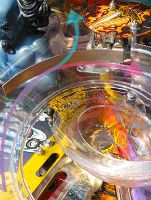
The long curved metal sheet going across this photo is a diverter from Tales of the Arabian Nights. When lifted up and out of the ball’s way, the ball will travel along the path denoted by the blue arrow. When lowered, it functions as a wall blocking the way, and the ball will travel along the pink arrow’s path. (Photographed by Allen Shope)
Toy – Can mean one of two things, or both: 1) A figure of a character or iconic object to the theme, or 2) A mechanism central to the game that is either not seen in any other game or was the first to use it, AND is really big and impossible to not notice. Fans like it best when they fulfill both definitions.
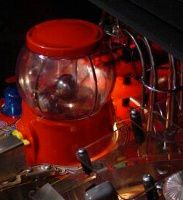
A toy from The Twilight Zone. This is a gumball machine that, once certain conditions are fulfilled, will dispense a pinball. You can also deposit a pinball into it if you like. (Photographed by Jeff Ball)
Bash Toy – The most common type of interactive toy, this is a figure, usually of an enemy, villain, antagonist, or annoying character, that stands on the playfield itself and can be hit with the ball. A bash toy has a sensor built into it that detects when the ball has hit it. Some bash toys raise themselves up do you can hit them, and some bash toys are always present. A few bash toys are of heroes or neutral characters, though. They tend to get snarky remarks aimed at the designers.
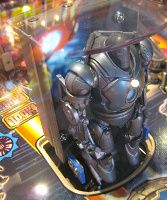
In Iron Man, Iron Monger will slowly rise out of the center of the playfield. He’s huge, he takes up a lot of space, and the designers placed him to encourage players to hit him with the ball repeatedly. (Photographed by Federico Croci)
Center Post – A short metal peg with a rubber ring at its tip, placed directly between the flippers at the bottom. Its purpose is to bounce a ball away that would ordinarily head down there. Physically identical to an outlane post, the only difference being its location.

Center post on Spider-Man Vault Edition, circled in cyan. Notice how far below the flippers the center post is--you'd better be sure the ball is heading towards the center post and not something else! (from a promotional image from Stern Pinball, Inc.)
Kicker or Raptor Kick – A solenoid at the end of a dead end that’s pointed towards the flippers. When the ball reaches a kicker’s range, the kicker will activate, sending the ball coming back down towards the player at a high speed.
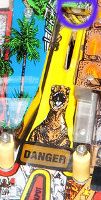
Circled in indigo is a kicker on Jurassic Park. It is the little white peg within that circle. Once the rollover switch detects the ball, the peg is timed to hit the ball and send it zooming back down. This mechanism is such a defining part of the Jurassic Park pinball machine, due to how it surprises players the first time they see it happen, that it gave the kicker its alternate name. (Photographed by Mark Steinman)
Vertical Up-Kicker, or VUK for short – A solenoid located within a scoop that sends the ball straight up. By this, I don’t mean towards the player, but towards the ceiling kind of “up.” Vertical up-kickers always have something directly above to guide the ball elsewhere, as you don’t want the ball slamming against the glass in the same spot again and again.
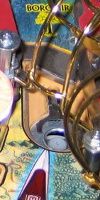
A vertical up-kicker from Lord of the Rings, or more precisely, the round gray hole towards the bottom. When the ball lands in it, the solenoid propels the ball upwards across the metal track above. (Photographed by Cassidy Thomas)
Stopper – A retractable cylinder located in the gap between the two bottom flippers, big enough to occupy almost the whole length of this gap. It spends most of its time lowered and flush with the playfield, but when raised, will prevent the ball from draining as long as the flippers are down. A ball can still escape between the stopper and a raised flipper, however. This is considered embarrassing.
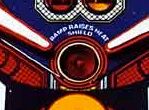
The stopper on Space Shuttle. The red circle lifts up when activated (Promotional image from Williams)
Gobble Hole – A hole that ends your ball. It looks like a scoop, but it won’t return the ball back to you. Sending a ball into a gobble hole is usually very valuable, as you’ve sacrificed your ball to it. Because of their game-ending nature, however, gobble holes went out of style in the late 1960’s, never to return.

A gobble hole on Slick Chick. Note the peg directly above it that encourages the ball to go in there. (Anonymous)
Passive Bumper or Mushroom Bumper – A msuhroom-shaped object that has a sensor inside that can detect that a ball has hit it. Unlike pop bumpers, these do not propel the ball away except through the ball’s own momentum, and they are much smaller than pop bumpers. Passive bumpers have no moving parts. As a non-interactive element, they were kind of boring, so they’ve become extremely rare in pinball machines made in the 1980’s and onwards.
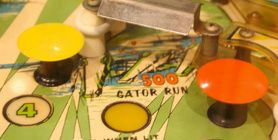
A pair of colorful passive bumpers on Gator (Anonymous)
Upper Playfield – A smaller playfield, raised above the main one. An upper playfield usually has at least one flipper of its own. Upper playfields stand out whenever they’re present, so machines with upper playfields tend to centralize around it. Losing the ball on an upper playfield feeds the ball back to the lower one. An upper playfield can have any of the objects listed above, though because of their raised nature, rollover switches and scoops are rare.

An upper playfield from Family Guy. It’s complex enough to be its own miniature pinball machine! (Photograph by Martin Ayub)
Under-Playfield, Cellar, Basement, or Sewers – A smaller playfield, at a lower elevation than the main one. The phrase “lower playfield” is not used because that refers to the main playfield where upper playfields exist, which are far more common than under-playfields. Machines with under-playfields have wide open center spaces in order to contain the window through which you can see the under-playfield.
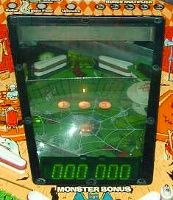
The under-playfield in Haunted House. Not every under-playfield is slanted away from the player though. Haunted House is notable for having both an upper playfield and an under-playfield, a result being that it was one of the most expensive machines to build of its time. (Photographed by John Kirby)
Knocker – Unless the machine is extremely damaged, you won’t be seeing this, but play for long enough and you’ll hear it (assuming you’re not deaf or hard of hearing). A knocker is a solenoid that makes a loud knocking sound to indicate to you (and anyone nearby) that you’ve won a free game.
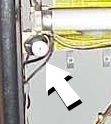
I think that’s the knocker on Ripley’s Believe It Or Not!, but I’m not entirely sure. They look like any other solenoid. (Photographed by John Gray)
There are a lot of other exotic playfield elements, but they tend to be found on only a few machines, or even just one, and are only worth mentioning when the tables themselves are being discussed. Examples include the perpetually-spinning automatic flipper in Monopoly, the magnetic slingshots in Ghostbusters, and the red flipper in Starship Troopers, though such elements are mostly classified as toys, which to many pinball fans is a “miscellaneous” counterpart.
Paths
In this category, I talk about things on a pinball machine that can guide the ball in particular paths, hence its name. Any in-depth discussion about pinball will require knowledge of these terms. Like with “Objects,” I will have an image of each of these too.
Drain - The hole at the very bottom of the playfield. You lose your ball if it reaches this spot. You do not want your ball to go down here. This word also exists as a verb; "to drain" means to lose a ball by letting it go down the drain. (Ex. "I only played for 5 seconds before my ball drained.")

The arrow points to the drain in Bowling Queen (Photographed by Russ Jensen)
Lane – A path on the playfield itself that’s slightly wider than the diameter of the ball. Lanes are designed to guide the ball down specific paths, either to an object at the end or back down to the player. So that the machine knows the ball has traveled the full length of the lane, most lanes have a switch at its entrance and another at its terminus or exit.
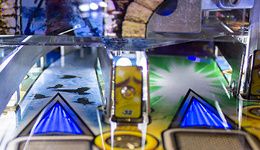
The entrances to two lanes, side-by-side, on Game of Thrones Limited Edition (Photographed by Martin Ayub)
Orbit or Loop – A lane that takes a curved path and returns the ball directly back to the flippers at the bottom. An orbit is a loop that comprises the outer perimeter of the top part of the playfield but is sometimes called a loop anyway.
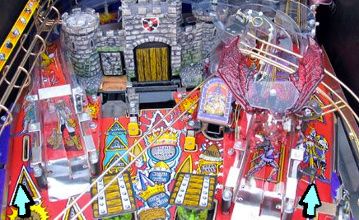
Both orbits on Medieval Madness are visible in this photograph, whose entrances I marked with arrows. (Photographed by Allen Shope)
Plunger Lane - The lane that the plunger is in. Balls enter the playfield here and are placed onto the plunger. A game does not officially begin until the ball leaves the plunger lane and enters the playfield at large.

The plunger lane on Pabst Can Crusher. Notice the ball resting on the plunger at the bottom. (Promotional image from Stern)
Ramp – A raised path. The ball goes up the entrance, then travels along the raised path. At the end of a ramp is a hole where it’s dropped off elsewhere, usually an inlane (which, as you can see, is the next definition), but sometimes in the middle of another ramp. On rare occasions, the end of the ramp is an incline downwards where the ball can also enter, but these are rare, and I can’t think of any examples. Ramps have been ubiquitous in pinball since 1987, probably because they allow designers to build over other things. Like with lanes, switches exist at a ramp’s entrance, but the second one is normally at the ramp’s highest point, as it can be assumed once the ball passes the peak, it can make the rest of the trip. Ramps are the most common uses for rollunder switches.
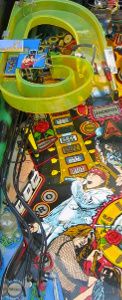
A ramp in Guns N’Roses. Look carefully, and you can see the entire path for the ball to take. (Photographed by Allen Shope)
Inlane or Flipper Return Lane – A special type of lane found at the bottom third of the playfield, traveling behind the triangular slingshots and to the flipper. Since the standard layout has two flippers at the bottom, the standard layout also has two inlanes, one for each flipper. Most ramps feed into an inlane so that the ball can safely travel to a flipper.
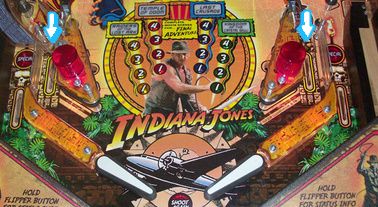
The inlanes in Indiana Jones, marked with arrows at each entrance (Photographed by Nile Roberts)
Outlane – Like inlanes, you can find these at the bottom. They are further out than the inlanes, giving them their name. Whereas an inlane feeds to a flipper, an outlane feeds to the drain, so you want to avoid letting the ball go down an outlane whenever possible. On some machines, the left outlane contains a kickback, which sends the ball back up and back into play. A few machines have alternate ways to save the ball too. At the entrance to each outlane is an outlane post (which I defined up in “Objects”). Modern machines allow you to adjust the position of the outlane post within a small range, effectively controlling the width of the outlane’s entrance. Although you’re only moving it by a few millimeters, this dramatically affects the ball’s likelihood to enter the outlane. Particularly cruel operators can also remove the outlane post completely if they don’t mind getting punched in the face.

The outlanes in No Good Gofers, marked with arrows at each entrance (Photographed by Christopher Wolf)
Tunnel or Subway – The inverse of a ramp, a tunnel is a path that takes the ball under the playfield. The ball falls into a scoop-like hole, then emerges out from another hole. Tunnels require a good strong solenoid at the end of the path that can chuck the ball back out.
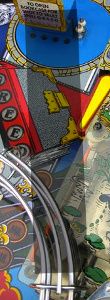
Although it’s not visible, this is an approximation of a tunnel’s path in The Addams Family. Get the ball behind the blue bookcase at the top, and the ball will emerge out of the swamp below. (Photographed by Allen Shope)
Techniques
Now that you can identify most things on a playfield, we're going to talk about techniques players use. Pinball has a reputation for just using the flippers and praying the ball bounces to where you want, but in reality, experts have tight control over the ball, and in doing so, also control the pace of their play. That’s the secret to their success. Over the decades, players have developed a lot of different ways to not drain. Some of these are illegal to use in competitions; those will have a ILLEGAL! tag.
By the way, all of the diagrams I use begin on the left side. For every technique except for the Death Save, they can also be mirrored if you begin on the right. And yes, all of them are possible. I’ve done all of them except for the illegal maneuvers. I’d prefer to have a recording where I perform them, but I can’t really film it without the camera getting in my way.
Shot – A use of the flipper by the player to propel the ball. The verb form of this, of course, is “to shoot.” Sometimes, a use of the plunger to send the ball into play is also called shooting, but if the words “shoot” or “shot” are used without context, it refers to using a flipper. Aiming your shots so they travel in the direction you want is key to doing well.
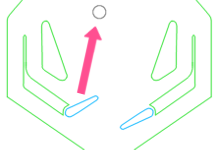
Soft Plunge or Controlled Plunge – This is when you launch the ball from the plunger without pulling the knob back all the way. Naturally, this can only be done on machines with manual plungers. Soft plunging is used for if you want to begin your ball somewhere other than where it’ll go with a full plunge. On some machines, soft plunges are recommended as they bring the ball safely to a flipper rather than wildly bouncing around somewhere else.

Cradle, Trap, Catch, or Hold – An absolutely fundamental skill to play decently, cradling is the act of keeping a ball trapped on a raised flipper. You see, when you hold the flipper button, the flipper stays up. If the ball has low enough momentum, it will stop before it reaches the tip of the flipper, allowing you to keep the ball there for as long as you’d like. While doing so, you can plan which shots you’ll make. And since the ball is at a known fixed speed (that is, stopped), you can let go of the flipper and time your shots to be more accurate.
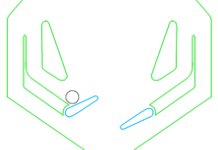
Flipper Pass – An act of using a flipper to send a cradled ball from one flipper to the other. Some shots are more easily done from one flipper to another. There are two types of flipper passes.
Post Pass – This flipper pass is done by shooting the ball at the bottom-most corner of the slingshot on the opposite side. The post making up that corner will absorb the ball’s momentum, allowing you to catch it on the opposite flipper.

Tap Pass or Flick Pass – This flipper pass is done by letting go of the flipper button for just an instant, allowing the flipper to go down a tiny amount, then pressing it again, sending the flipper back up. The small distance the flipper has traveled going up means it imparts only a small amount of energy onto the ball. If done right, this will allow the ball to gently and slowly arc over to the other flipper.

Dead Pass, Bounce Pass, or Dead Bounce – If the ball is coming down towards the wrong flipper and you think it’s the right speed, you can simply do nothing and let the wrong flipper’s rubber bounce the ball to the right one. While you need good judgment of the ball’s speed and the machine’s steepness, friction, and flipper angles to consistently do good dead passes, if you pull one off, the ball will always lose enough momentum on the bounce to be safely cradled on the other flipper. This is the technique that requires the most skill in judgment but the least skill in timing. The Twitch streamer Deadflip named himself after this technique.

Live Catch – Raising a flipper as the ball is coming down such that the flipper is fully raised the moment the ball hits it. This transfers the ball’s momentum into the flipper, causing it to seemingly stop, then roll down harmlessly. If done incorrectly, it could leave the inlane through the top and bounce into the outlane, or roll back up the flipper and fall off the tip straight into the drain. Live catches are why, when you see experts playing, it looks like the ball is bouncing a lot less than it normally should.

Dead Catch or Drop Catch – The opposite of a live catch, a dead catch is leaving a flipper raised as the ball is coming towards it, then lowering the flipper the moment the ball touches the flipper. Undoubtedly a more difficult technique than the live catch, but it can cover a wider range of situations than a live catch and is the only way to stop the momentum of a ball on a path towards the middle. (You can just leave the flipper up and hope it bounces in such a way that you can catch it though.)

Inlane Pass, Alley Pass or Schatzing – Inlanes sometimes have nice awards, but unless there’s a ramp that directly feeds to the inlane, it’s risky to try to get the ball to go down an inlane because the outlane is right next door. Instead, you can let the ball roll down a lowered flipper, then flip at the very, very tip of the flipper. If all goes well, the ball will travel up the inlane on the other side. Also known as Schatzing, named after Neil E. Schatz, who is well-known among top players for doing this really well. There is a risk that the ball has some horizontal top-like spin to it that can send it over the top of the inlane and then into the outlane, however. This incident doesn’t have a universal generic name but is sometimes called Taxi-ing, due to how often it happens in Taxi.

Cradle Separation – During a multiball, you can catch more than one ball on the same flipper. A cradle separation is the transfer of one ball from one flipper to the other while leaving the other ball or balls on the same flipper as before. Doing it wrong will cause the transferred ball to fall down into the center drain instead. Even top players struggle with this. See multiball under “Rules” and Elwin Maneuver under “Competitions” for more information.

Straight Down the Middle, abbreviated as SDTM – Not really a technique, but this is the closest category I have for this phenomenon. A “straight down the middle” is an instance where a ball drains by taking a path through the gap between the flippers in vertical or nearly vertical line. Such a drain is unavoidable at a high speed. Without good nudging skill, it’s also unavoidable at a low speed.
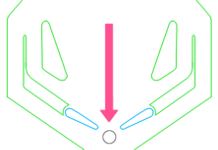
Nudge – Giving the machine a little shake. No, this is not cheating, and all pinball machines from 1929 and onwards are designed knowing people will shake and jostle it. When you nudge the machine, you are briefly changing the ball’s location. Because the ball is, well, spherical, and due to inertia, the ball will want to remain in the same location in space. Hence, nudging the machine left will cause the ball to “move” right relative to the playfield, and vice versa. Most machines will allow you to nudge by about 1 or 2 millimeters, but that’s enough for expert players to almost never drain down the middle by moving the playfield so the ball is in range of a flipper. Nudges can also help prevent drains down the outlanes by imparting more momentum onto the ball, causing it to bounce off the rubbers a bit more and hopefully enough to get it back away from the outlane. Nudges must be done delicately and sparingly, as the machine will penalize you for overly vigorous nudging. See “Warning,” “Tilt,” and “Slam Tilt” under Rules for more detail. The assembly of a pinball machine makes it such once the player lets go after a nudge, the machine will spring back into how it was before.
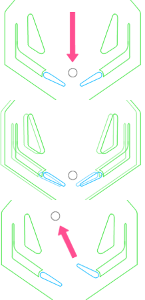
Brick - Not a technique you want to do very often, you brick whenever you want to shoot for something, but you don't get it and the ball just comes rolling back down. Bricking can occur either by missing your shot, causing it to hit something not worth anything, or you get your shot but, due to physics, the ball just bounces back withot the machine registering anything. Machines manufactured by Bally have a tendency to do this, and the latter is sometimes known as the "Bally Brick" because of that.

Death Save ILLEGAL! – A technique in which, after a ball has gone down the left outlane, you hold the left flipper up, and once the ball is below the left flipper, you give the machine a good strong nudge upper-right. If done with the right level of force and the right time, the ball will bounce up between the flippers, putting the ball back into play. This technique will get you immediately disqualified in a competition, because you can theoretically save the ball indefinitely in this way.

Bang Back ILLEGAL! – Another technique that can save your ball indefinitely, this one also starts out similarly: Hold the left flipper as the ball goes down the left inlane, only instead of a nudge, you punch the bottom of the machine where the ball is at, This can cause the ball to fly over the flippers. This is an old technique, and machines of the mid-20th century sometimes had nails installed to the bottom of it, making it a literal “dangerous forbidden technique.” And, like the Death Save, the Bang Back is illegal to use in all competitions and will instantly disqualify you.

Mechanics
All games must have rules, and pinball is no exception. The complexity of pinball increased dramatically as technology moved forward and continues to evolve. To play a pinball machine well, you must also understand its rules. These are some common ones. Most of them only apply to pinball machines made in 1989 and later, but I'll explain that in more detail under "History." These are all important to know: Pinball machines use these terms, either printed on the machine itself or written on the display, with the assumption you know what they mean. This time, not every entry will have a picture, as not all of them can be easily visualized.
Ball (mechanic), also known as Ball in Play - The period of time between when your ball has entered the playfield to the time it drains and you receive your end-of-ball bonus or tilt (see below). You begin at Ball 1. When that ends, you move on to Ball 2, and so forth. In essense, this is the pinball equivalent of a video game's lives. Games made before 1980 will end after Ball 5 drains. Games made in 1980 and later will end after Ball 3 drains, possibly to mimic a video game's tendency to start with 3 lives.

The indicator for which ball is in play in Free Fall, accounting for any number of balls in the game up to 10. (Photographed by Jay Stafford)
Score - Your running total of points. The purpose of a pinball game is to get as many points--that is, as high a score--as possible. The scale of your score wildly varies depending on the machine. You have to be really good to get a score above 1,000 in Royal Guard, for instance, but on Johnny Mnemonic, it’s a bad game if it doesn’t reach 1,000,000,000.
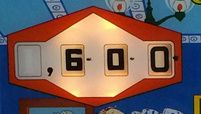
King of Diamonds is a very low scoring machine. Here, someone achieved a score of 600. (Photographed by Jim Chippi)
Scoring - A temporary game state where one or more objects or paths score more points than usual. Usually, this runs on a timer, and when time runs out, they revert back to their normal scoring. Sometimes, it continues until the ball drains. On top of that, some games give you a big fat point award for reaching certain milestones.
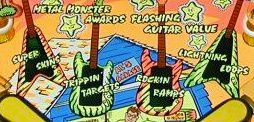
Inserts in Al’s Garage Band Goes on a World Tour. When any of these are flashing, it indicates that all of those objects and ramps on the playfield are worth more points than normal. I’m not familiar enough with this one to know what “skins” means, but it’s a term specific to this machine. (Photographed by John Kirby)
Playfield Multiplier - A type of scoring where everything scores more points than normal. Because of the huge potential of a playfield multiplier, they are hard to obtain and either have low multipliers or only occur rarely and under specific conditions.
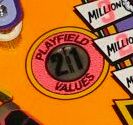
An insert from The Party Zone. It reads “Playfield Values 2-for-1,” meaning all scores are doubled as long as this is lit. (Photographed by Frank Ersfeld)
Shot Multiplier – A state in which a single shot is multiplied by its base amount.
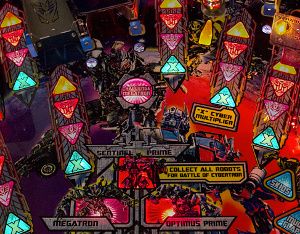
Transformers has a shot multiplier for each ramp and lane. It’s indicated by the turquoise “X” inserts. When they’re on, anything shot there scores double. Otherwise, it’s normal scoring. (Photograph by Martin Ayub)
Ball Saver - A feature where, if you drain the ball a very short time after it begins, you will be compensated a new ball with no consequences. The game will treat it as if you never drained the ball. On most machines with a ball saver, you are allowed 1 per ball. Exceedingly uncommon in games made before 1993 but a standard with games made after that. You can tell a ball saver is active because an insert light near or between the flippers is blinking. (Machines from Gottlieb are the exception; such a blinking light means an extra ball, and Gottlieb's machines have no ball savers.) Ball savers are turned off in most competitions.
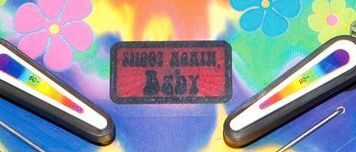
If this light on Austin Powers is blinking, you can drain the ball without worry. (It reads, “Shoot again, baby!”) (Photographed by Mark Steinman)
Call-Out - A voice clip. Most of the time, they're used to provide hints to the player or explain rules, though sometimes they're just used for flavor, characterization, or atmosphere.

It's kind of difficult to find a photograph of a voice clip on a pinball machine, so here's a picture of Call from Mighty No. 9 instead. There is no Mighty No. 9 pinball machine, for the record. No official ones, at least.
Skill Shot – A task assigned to the player when a ball begins on a plunger. It’s predominantly a very simple task that can be done with the plunge or the first flip, in the form of one location on the playfield that’s worth more if it’s the first place the ball reaches. If you fail to achieve the skill shot, you will have to try again on the next ball. The skill shot is loosely named after the shot attorney Roger Sharpe made in a court case to prove to the government of New York City that pinball is a game of skill, by declaring a rollover switch, plunging the ball, and having that rollover switch be the first non-plunger switch hit of the ball.
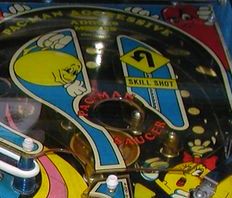
The skill shot in Mr. and Mrs. Pac-Man Pinball is marked by a yellow sign. If you can get the ball to go straight down instead of around when you begin, you’ll get a bunch of points. (Photographed by Christopher Wolf)
Combo – Two or more consecutive successful shots to lanes or ramps without any other shots in between, and in most cases, without a major delay between shots. Some machines reward extra points for combos, with an increasing amount for each time you make another shot without breaking the combo.

Cue Ball Wizard will reward you handsomely if you can get your combos, here known as “Combo Shots,” done accurately and quickly. (Anonymous)
Virtual Lock – A third type of lock, one that uses no physical component, which is why it’s called a “virtual lock.” In a virtual lock, instead of keeping a ball somewhere until it’s ready, the game will hold the ball, tell you it’s locked, and return it back to you. When it comes time to “release” the locked ball, the machine will load another ball at the plunger and automatically launch it into play.
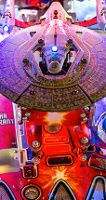
A virtual lock on Star Trek (Stern) (the area lit with red). If you can get a ball here, the game will tell you you’ve locked a ball, then return it to you. (Photographed by Martin Ayub )
Lit – Indicates a playfield element is active and will award extra points, begin something, progress through something, or otherwise something other than the basic paltry points it’s worth. For instance, when a lock is active, the phrase is “Lock is lit.” Named so because an insert in front of the object or path will light up, alerting the player that something is available there. Basically, in pinball parlance, “lit” is synonymous with “ready.”
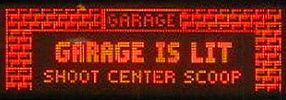
In Grand Prix, “Garage Is Lit” does not mean the lights are on inside of the garage. It means something will happen when you shoot it (which is the center scoop). (Photographed by Martin Ayub)
Relit – When something has become unlit and you want it lit again, you try to “relight” it where possible.
Mode or Mission – Objectives given to the player once certain conditions are met. All modes have names. For instance, in Monster Bash, modes have names like “Mummy Mayhem” or “Drac Attack.” Modes are self-contained and give fat points for progressing in it, then a large reward for completing it. If the machine is an adaptation of an existing work of fiction or otherwise has a story, modes also represent chapters or scenes from the source material. Hence, modes are a pinball machine’s counterpart to levels or stages in a video game, or maybe requests or sidequests. Clear enough modes, and the wizard mode will begin (see below). Due to how modes are worth a lot of points and progress you through the game, modes make up the meat of a modern pinball machine. Modes either begin by shooting at something (most commonly a scoop) when lit, or they automatically begin after shooting something enough times. There is tremendous variety among modes and can potentially be about anything; the next 13 entries cover different types of modes and mechanics found only in modes. Any mode that doesn’t fall into any of the below categories is simply called a “mode.” A few games allow you to select the mode you want to play, and a few games follow a fixed order, but in all other games with modes, either their order is randomized or each mode has different conditions to begin. The word “mission” is used in some machines and indicates they are the only modes required to reach the wizard mode, with everything else being optional.
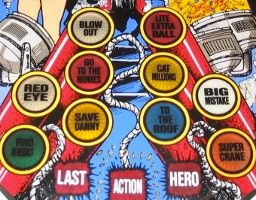
A group of inserts showing the 10 modes of Last Action Hero, plus the phrase “Last Action Hero” (Photographed by D. Maveus)
Timed Mode – A mode with a timer. These come in two flavors: Either the goal is to survive until time runs out, or the objective must be accomplished before time runs out. Sometimes, it’s both, where the mode is cleared even when you haven’t reached its end, but you’re given a bigger award for finishing it.
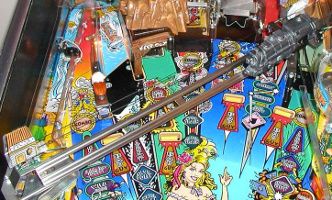
Most timed modes will simply have a timer on the display, but Cactus Canyon’s “Save Polly” has a train slowly move across the playfield. You’re supposed to rescue Polly from the train tracks before the train reaches the far left end. Yes, this train is also a “toy.” (Photographed by David Putsch)
Hurry-Up – A particular kind of timed mode where the player is asked to make a single shot in time. The quicker the player makes the shot, the more it’s worth.

When this light is blinking in Terminator 3: Rise of the Machines, shoot the ball to where it points to claim your reward. (Photographed by Christopher Wolf)
Multiball, M-Ball, or Tri-Ball – Any mode where 2 or more balls are in play at the same time. Most commonly, a multiball begins with 3. Multiballs don’t include captive balls or accidental multiballs (such as through a mechanical malfunction). The machine knows how many balls are in play in a multiball. When a ball drains, it will allow the player to continue playing with no interruptions until either only one ball remains, upon which the multiball will end; or no balls remain upon which the ball (under the rules definition) will end. Multiballs are rarely required to reach the wizard mode but not unheard of and are treated as a bonus for playing well. Most multiballs contain enhanced scoring of some kind, the most common ones being the Jackpot system (see the two entries below) and playfield multipliers equal to the number of balls in play. Some multiballs have objectives of their own independent of either of those, and you are supposed to accomplish it before you’re down to only 1 ball. Though it was not common before, it’s now standard for multiballs to begin with a ball saver (even in competitions). Due to their spectacle-like nature and large point yield, multiballs are the potatoes of a pinball machine, though there are a few, such as AC/DC and Godzilla, where multiballs are front-and-center. Williams trademarked the word “multiball” in 1980, and it expired in 1999. During then, other manufacturers had to find other names for it. “M-Ball” and “Tri-Ball” are terms both used by Data East. Due to Gottlieb using the word “multiball” before Williams trademarked it, Gottlieb was allowed to circumvent that trademark. However, Gottlieb rarely used the word, preferring to give multiballs their own names without using the word “multiball” in it, such as “Cats & Dogs” in Tee’d Off.
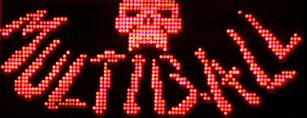
The dot-matrix display in CSI indicating that Skull Multiball is about to begin (Photographed by Martin Ayub)
Jackpot – A large points award. Originally, this was what you were striving for the whole game and was the reward at the end. Eventually, the word came to be associated with multiball and is any points award given out exclusively in a multiball mode. At least one jackpot is available at the beginning of all multiballs in modern machines somewhere on the playfield. Depending on the game, it can potentially be anything, such as stand-up targets in Waterworld, the piano scoop in The Twilight Zone, or the ramps in Medieval Madness. After that, either the jackpot remains lit for the entirety of the multiball, or something else must be done to relight it. Multiballs can have multiple jackpot locations, but not always. The original definition is related to jackpots found in slot machines and other gambling devices, but the meaning in pinball has deviated a lot. In addition, jackpots have become trivialized, with double jackpots, triple jackpots, and so forth becoming commonplace. Sometimes, jackpots are named according to their theme, such as “Safe House Jackpot” and “Nuke Jackpot” in 24. The use of the word “jackpot” and its mainstream association with gambling has made some licensors uncomfortable, such as the NBA. A result is that no games with an NBA theme refers to these awards as jackpots.
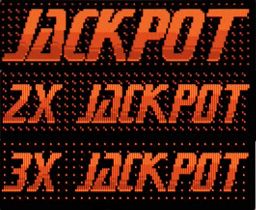
A screenshot collage of the animations Star Trek: The Next Generation uses for its Jackpot, Double Jackpot, and Triple Jackpot. It shows you just how trivialized the word “jackpot” is compared to slot machines or lotteries.
Super Jackpot – The highest jackpot one can have during a multiball. This is obtained by performing exceptionally well without letting the multiball end, such as moving up the ladder of jackpots all the way to the top. Most multiballs in recent years have a super jackpot, but they did not become common until then. Because obtaining a Super Jackpot can be considered more or less clearing a multiball mode, getting at least one Super Jackpot is required on a few machines to get to the wizard mode. “Super Jackpot” is always capitalized in this way, probably because the designers want you to understand that it’s a big deal.
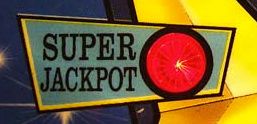
Getting the Super Jackpot in Wheel of Fortune’s main multiball is one of the tasks you must accomplish to get the Wizard Bonus. (Photographed by Martin Ayub)
Add-a-Ball – This can mean one of two things: Either it’s a type of machine from the mid-20th century that allows you to play extra balls in such a way that circumvented United States gambling laws at the time, or, in more modern times, a feature during a multiball that, when activated, sends one more ball into play. The ball saver also begins again when this happens. Add-a-balls whose activation is controlled by the player (such as through pushing a button) are a godsend to a savvy player, because they can time it right when the penultimate ball drains, effectively rescuing their multiball from ending.

The Fire button from AC/DC. It has a few different uses, but one of them allows you to add one ball to any multiball by pushing it while it’s active. This button is located in the middle at the front. (Promotional image from Stern)
Frenzy – A timed mode where all switch hits have a fixed amount of points in addition to what they would normally score. If they don’t normally score, the frenzy awards that fixed amount of points. When the timer ends, the game’s scoring goes back to normal. When in a frenzy mode, you want to head for the spinners and bumpers, as they offer rapid switch hits.
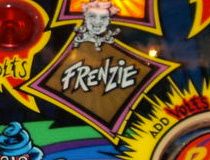
The insert depicting “Ringmaster Frenzie” in Cirqus Voltaire (Photographed by Kim Mitchell)
Video Mode – A mode that plays out on the display instead of the playfield. Video modes always begin when the ball is resting safely in a scoop. They are essentially simple mini-games played using the flipper buttons. Most of them are also unresponsive and clumsily programmed. Common in the 90’s, they fell out of popularity in the mid-00’s and are rare nowadays.

Iron Man fights Thor in The Avengers. Remember that scene? This isn’t actually a video mode, but was planned to be one. (Direct DMD feed from Pinball News)
Stacking – Having multiple modes going on simultaneously. This is completely up to the intent of the designers. They are the ones deciding which ones you can combine and can’t combine. A general rule is that you can bring a multiball into regular modes, but you can’t start any more modes except other multiball modes until a multiball ends. In some games, the key to doing well is stacking, as the modes are designed to fit in with other modes, and certain shots will provide multiple awards. Good strategization tends to involve knowing which modes can be activated and picking the right ones to go with each other. Commonly, savvy players will combine a mode they know they’re bad at with a multiball to provide additional chances to shoot things and as insurance in case they drain a ball.

Sorry for the tiny image, but this was the best I could do. These are the three multiballs in Bram Stoker’s Dracula: Coffin Multiball, Castle Multiball, and Mist Multiball. Any combination of them can be active at once. (Promotional image from Williams)
Collecting – Same as in a video game: Gathering in-universe items that will reward you when you get enough of them. The word “collect” is used even for gathering stuff that you’d normally not use the word for in real life, such as dirt in Waterworld, or when no act of collecting is actually taking place in-universe, such as the bandmembers of Metallica reuniting. That is, the word is used solely as a game mechanic, not describing what’s going on in-universe. Congo has the most pronounced case of collecting: Modes reward you in diamonds rather than points, and collecting 100 diamonds takes you to the wizard mode.
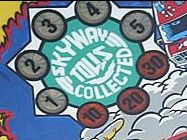
The circle of inserts here tell you a running count of how many Skyway Tolls you’ve collected in Whirlwind. Add up the ones that are lit to get your total. This stops working once you’ve reached 76 of them though. (Photographed by Allen Shope)
Spot – A type of aware in which, instead of points, the game provides you with something for free instead of you having to work for it. For the most part, any points you would receive by obtaining it normally will also be awarded to you.

Getting this award in Taxi will immediately score 25,000 points, and the game will also provide you with a passenger without you having to find him or her. (Photographed by Mike Ives)
Spelling Bonus – Not to be confused with “end-of-ball bonus” below, this phrase is always spoken or spelled out in its entirety as “spelling bonus.” In most pinball machines made after a certain point, at least one shot will be worth 1 letter of a word or phrase per shot. Once you fully spell it out, you get an award, most commonly a mode.
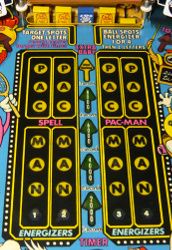
In Baby Pac-Man, shooting any of the drop targets at the top will light the topmost unlit letter in the word “P-A-C-M-A-N” directly below. Finishing Pac-Man’s name awards an “Energizer,” this game’s interpretation of a Power Pellet, allowing Baby Pac to turn the tables on the ghosts. (Anonymous)
Sub-Wizard Mode – One of two things: 1) Either a mode placed right before the wizard mode to build up tension and let you know you’re almost there, such as the aptly named “Calm Before the Storm” in Gladiators, or 2) A mode that functions like a wizard mode but is not at the end and is less valuable than a wizard mode, such as “Kobayashi Maru” in Star Trek. They are still worth getting to, however, because sub-wizard modes are still a few steps up from regular modes in points potential, and it means you’re good enough to get there.

The WPT World Championships is, in fact, NOT the end goal of World Poker Tour. Rather, it’s one of the seven goals to qualify for “Keefer International,” which is WPT’s real wizard mode. (Photographed by Vincent Giovanonne)
Wizard Mode – The last mode in a pinball game’s “story.” Named so because you have to be a “pinball wizard” to get there, which was in turn coined by The Who’s rock opera Tommy. Wizard modes represent the ultimate goal and have names like “Battle for the Kingdom” (Medieval Madness) and “The Final Frontier” (Star Trek: The Next Generation). Because you’ve been playing the entire time to reach this, the wizard mode is also suitably chock full of points for doing practically anything. Most (but not all) wizard modes are multiballs, using every non-captive ball the game has available. And appropriately, the sound is always turned up a little more during a multiball. Wizard modes, like regular modes, can have any kind of rules and fall into any of the above categories of modes (except sub-wizard mode). Once you complete a wizard mode, the game either goes to a victory laps mode or begins again, usually with a higher difficulty and/or higher point gain.

“Demon Battle” is the wizard mode of America’s Most Haunted (Promotional image from Spooky Pinball)
Victory Laps – A mode found after completing another mode. In most cases, the completed mode is the wizard mode and themed around a celebration of some sort. In this mode, ramps and lanes are worth much more points than usual, and the mode continues until the multiball ends, or in some cases, the ball drains. If the victory laps are for a wizard mode, ending the victory laps will reset the progress back to the beginning, sometimes with a few things that stay completed. If the victorylaps are for any other mode, the game resumes as normal.

24 is one of those exceptions—it throws victory laps within its multiballs. (Photographed by Martin Ayub)
Extra Ball – Pinball’s counterpart to the extra life, an extra ball allows you to play one more ball before the game ends. You may earn multiple extra balls before the game ends, though some games have a cap on how many you can get. However, extra balls do not add to the ball counter, so a 3-ball game will never go to Ball 4, no matter how many extra balls you get. For instance, if you get an extra ball during Ball 2, the next ball, your extra ball, will still display Ball 2. In most modern games, there is one extra ball that’s relatively easily obtained, with other extra balls obtained through chance or doing incredibly well. Extra balls are not used in most competitions, and they are either turned off through the machine settings, or they are to be plunged, then ignored.

This insert will let you know if an extra ball is available on The Champion Pub. (Photographed by Mark Winter)
Special – For a lack of a better term, a special reward for either being lucky or advancing really far. Extra balls are rare, but specials are so seldomly awarded they make extras balls look common. By default, specials are treated as a free game, but they can also be adjusted to be an extra ball, a predetermined number of points, or absolutely nothing. Specials are a holdover from earlier decades: Since they counted as free games, the number of credits deposited into a machine will increase by 1 each time a special is earned. Some establishments would then allow you to trade in your credits for things sold on the premises, like food, drinks, or toys. They open the machine up, reset the credits to 0, and give you your free stuff. Nowadays, this practice feels too close to gambling for most places to allow it. Consequently, specials became extremely rare, lit when you get close to the wizard mode, usually in an outlane so you have to lose a ball anyway (unless you get it during a multiball).
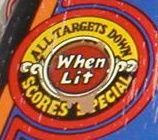
The pinball machine for Capt. Fantastic and the Brown Dirt Cowboy lets you know exactly how to get a special. (Photographed by Vic Camp)
Random Award – When pinball machines became computerized, random awards were not far behind. As the name suggests, this is an award whose effect is randomly chosen. Random awards could potentially be anything from a measly amount of points or a free ramp shot to multiballs, extra balls, and specials, but the full range varies from game to game. In competitions, random awards will either be disabled (whether physically or in the rules) or adjusted such that the sequence of awards is identical for all players. Random awards are predominantly given out in scoops to allow the player to see which award he or she has earned.
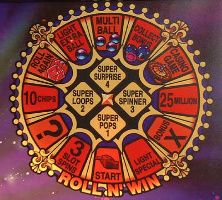
A wheel of random awards in High Roller Casino. Usually, they’re not displayed out like this, but comes in the form of a scrolling list. (Photographed by Martin Ayub)
Status, Status Report, Info, or Status Info – Hold a flipper button down for long enough, and if it’s new enough to have a display, the machine will show you your progress. What it actually tells you differs from game to game, but if there’s any information you can’t tell just by looking up, chances are it’s there in the Status menu. This is basically a pinball machine’s counterpart to a pause menu. Naturally, you can only do this while you’ve caught a ball on a flipper.
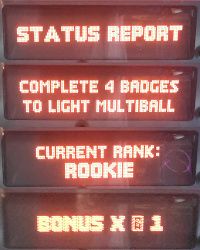
This is the sort of information you get when you hold the flipper button down long enough in Dirty Harry. It gives you some insight into the game’s mechanics.
End-of-Ball Bonus (sometimes shortened to just Bonus) – Were you wondering why I used the words “award,” “reward,” “points,” and such, but never “bonus”? This is why. The word “bonus” is used in pinball to refer specifically to the end-of-ball bonus. This is a points award given out after draining a ball. The game keeps a running tally of various things, then gives you a certain number of points times however many times you did that thing during the ball. Which things and actions they are depends on the game, but it’s expected that the end-of-ball bonus is worth a minimum amount. Once they are all added to your score, the next ball begins. Hence, you can also define a “ball (mechanic)” as the time after the game begins or the last end-of-ball bonus to the next end-of-ball bonus. Drains of additional balls due to multiball and drains when a ball saver is active will not award an end-of-ball bonus. The importance of end-of-ball bonuses to your score varies a lot between games, from nonexistent (NBA Fastbreak) to dwarfing the rest of your score (El Dorado). The spealling bonus is the only other pinball mechanic that’s allowed to be called a “bonus.”
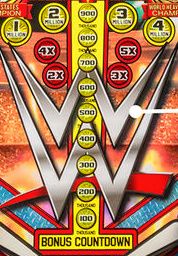
A set of inserts showing your end-of-ball bonus in WWE Wrestlemania. Usually, it’s not shown to you until the ball drains, however. (Promotional image from Stern)
Bonus Multiplier or Bonus X – Multiplies the end-of-ball bonus by a particular integer. Always begins at x1, and nearly all machines have x2 as the next one up. The cap varies a lot by machine, which can be as low as x2 or as high as x999, but good luck getting that many.
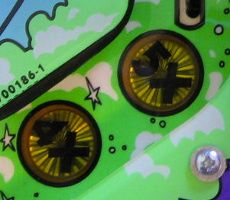
Inserts on Big Bang Bar showing bonus multipliers for x4 and x5 (Anonymous)
Hold Bonus - Usually, the end-of-ball bonus resets to 0, and the multiplier resets to x1, when you drain. Activating Hold Bonus allows you to pick up where you left off on the next ball. (You still get the previous end-of-ball bonus.) I’d say 95% of all Hold Bonuses derive from two sources: Exceeding the maximum bonus multiplier or from a random award.
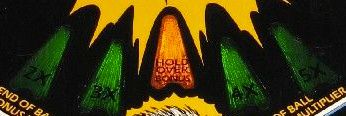
The Hold Bonus insert from Laser War is in the middle here. You obtain it by reaching x8 bonus, and the next one is “Hold Over Bonus.” (Photographed by Stefan Ordelman)
Tilt – You may have seen in cartoons like Looney Tunes or Tom & Jerry some character bouncing around with stereotypical pinball noises, then ending with “TILT” somewhere on the screen. A tilt is a penalty for nudging and shaking the machine too hard and too often. During a tilt, all the lights on the machine go out except for whatever displays the word “Tilt,” and all of the sound goes out too. The flippers stop responding, forcing you to drain. You do not receive your end-of-ball bonus. The standard for tilts during the days of those cartoons is that a tilt immediately ends your game and you forfeit any balls you haven’t played, which is why those cartoon scenes end with a “TILT” sign. Machines made recently only force you to forfeit your end-of-ball bonus and will move you on to the next ball after a few seconds (unless it’s your last ball, which a tilt will end your game).

A faintly visible tilt sign in Skylab. Causing a tilt makes this area light up and plainly visible to the player.(Photographed by Jean-Pierre Renault)
Warning, Tilt Warning, or Danger – Once displays got sophisticated enough to display words, players were given the message “Warning” or “Danger” on the display if they jostled the machine enough. The most common number of warnings is 2, with the second warning often reading either “Warning Warning” or “Danger Danger” to make it clear it’s your second warning. After your last warning, further heavy nudging or shaking will induce a tilt penalty. Gottlieb machines would accompany warnings with a loud beep in case you’re not looking up.

I received two warnings playing Johnny Mnemonic. As a result, the machine flashed dark except for the phrase reading “Danger Danger” on the dot-matrix display.
Slam Tilt – A new type of tilt penalty made to replace the original one, a slam tilt occurs when the player is so rough to the machine that he or she could damage it and/or injure bystanders and other players. The easiest way to invoke a slam tilt is to lift the front of the machine. Like the old tilt, a slam tilt ends the game immediately. A few machines will shut off entirely and not let anyone play it until someone with access inside resets the machine.
Neither I nor anyone else is going to Slam Tilt a machine just to get a photograph!
Game Over – The phrase you see when your game ends. I don’t think this needs further explanation.

The light has turned on indicating this game of Centigrade 37 is, in fact, over. (Photographed by Patrick Dellosso)
Match Sequence – Something played out on the display after a game ends, which always ends in a two-digit number being displayed, with the exception of The Wizard of Oz, which is 1-digit. If this two-digit number matches the last two digits of your score, the knocker goes off and you get a free game. Because nearly all pinball machines score strictly in multiples of 10, it may look like you get a 1-in-10 chance, but this is misleading: Match percentages, by default, are currently set to 7%. The machine decides in advance if you’re going to get a free game and will display matching numbers or not. Early match sequences simply spat out the number, but as time went on, the designers and artists got more creative, and presently, match sequences are full-blown cutscenes.
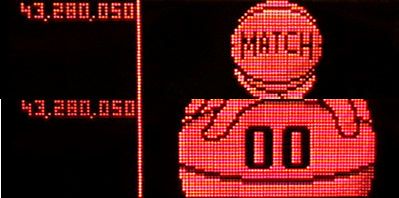
The match in NBA depicts a basketball with the word “match” written on it, which then reveals the number on the other side. As you can see, they did not match. (Photographed by Martin Ayub)
Replay – A free game given out by surpassing a predetermined score. The moment you surpass it, the knocker goes off and you get your free game. This score can be set by the operator. In addition, operators have the option to either keep this amount fixed (does not change from game to game) or make it dynamic. A dynamic replay score will rise after a game in which a player reaches the replay score and continue to rise as they reach it again in subsequent games. Once a certain number of games go by with no one reaching the replay score (usually 3), the replay score resets back to its minimum. Also, operators have the option to not have a replay score at all.
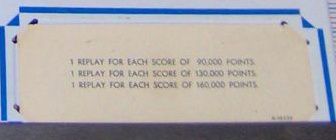
Joker Poker was made at a time when replay scores were fixed. As a result, the scores needed to win free games was printed onto a card and attached near the plunger. (Photographed by Jim Palson)
Three-Switch Rule or Playfield Validation – A decades-long anti-frustration measure, but one you’d probably never notice unless told to you, a ball does not officially begin until it trips the third switch. That is, if you drain before the ball has touched three switches, the game will quietly just give you another ball and let you try again, and this can be done as many times as is necessary. Switches in the drain don’t count, but the switch on the plunger lane does. Essentially, if the score on the display is flashing, it means the ball has not yet begin. When it stops flashing, the ball is now in play and you have to play normally. It used to be simple, but Cayle George (“KAY-lee”) mastered abusing this rule, causing manufacturers to playtest three-switch abuse and create exceptions. This is sometimes called “playfield validation” because the playfield will not yet acknowledge (that is, validate) the ball until its third switch.
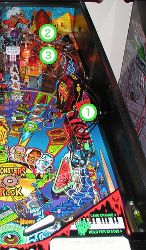
I placed these dots at the approximate locations of the first three switches in Monster Bash your ball is most likely to trip if you do the usual full plunge, and this sequence is required if you want the skill shot. If you want to cheat the three-switch system that badly, you can soft plunge, hitting only one switch before falling to the flippers. (Photographed by Christopher Wolf)
High Score – Just like any other game in the arcade, pinball machines keep track of the top scores. The standard amount is 4, going from High Score #1 to High Score #4. If you get a high score, you put in a three-character combination (they’re supposed to be initials, but you can put in any combination you’d like; an exception are Stern’s machines from 2012 and later, which allow up to 10 characters), and unless the operator has disabled it, the knocker goes off and you get a free game. These scores are reset after a certain amount of time has elapsed, usually months but sometimes weeks, so as to avoid permanent domination by one REALLY good player.

This is my #1 high score on Terminator 2: Judgment Day at Anime Expo 2016. The scores were reset the following day, so my score was gone.
Grand Champion, sometimes abbreviated as GC – Actually, there is a fifth high score. The Grand Champion is above the other high scores and is essentially High Score #0. Technically, this means High Score #1 is actually the second highest score, High Score #2 is the third highest score, etc. It is confusing and bewildering. Unlike the high scores, the Grand Champion score remains on display until the machine’s save memory is deleted or someone gets an even higher score. If you get the Grand Champion score, the knocker will go off three times, and you get three free games (unless the operator changes it to something else).
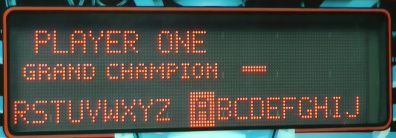
Bowen Kerins gets to enter in his initials because he achieved the Grand Champion score in Demolition Man. (Photographed by Bowen Kerins)
Patch or Update - This is the same thing as patches in video and computer gaming: A small (well, usually small) file to be downloaded into the game after it's already come out, for the purposes of fixing bugs and glitches, removing exploits and loopholes (like Cayle George’s abuse of the three-switch rule), adding new content, and competitive balance. The most recent games have Internet connectivity for this purpose, but USB compatibility has existed since at least 2001. So far, all pinball updates are free; there has been no DLC yet.

As of the time I’m typing this, Mustang Pro Edition is on version 1.45. (From the Stern Pinball website)
Multiplayer - All modern pinball machines, and most older ones, support multiplayer, with up to 4 players (6 for SEGA's pinball machines). To initiate multiplayer, simply press the start button to start a game, then press the start button again for each additional player before you begin playing. Multiplayer plays out exactly like the single-player mode, only each player takes turns at the machine, the next player stepping up after the previous player's ball drains. The exception is if a player has earned an extra ball, which allows that player to play another ball immediately after the last one (hence why the insert often reads "Shoot Again" and why you often hear voice clips like "Stay where you are!" or "Don't move").

Monte Carlo (1972) can support up to 4 players at a time. The lights below “1 to 4 can play” indicate which player’s turn it is. (The 1987 version can too, but this one says it out loud in the corner.) (Anonymous)
Free Play – A setting where games are free and don’t require you insert any money in. For some reason, replay scores and match sequences are still present when set to free play. You find machines set to free play at competitions, special events, in private residences, and locations that charge by time rather than per game.

This message indicates to anyone passing by that they can play on that Star Wars: Episode I machine without having to pay. (Photographed by Marco del Ry)
History
Why is this section here? Because it will tie up a lot of different things I described above. As technology advances, pinball machines become drastically different in how they play. None of these terms will be of any importance when you're actually playing, but they are useful when describing a machine. The following are the five eras of pinball (possibly six), each with their own characteristics, and are in chronological order. You will notice there is always an overlap of a few years between eras. That's because not every manufacturer switched from one technology level to the next at the same time, and there are transitional periods as a result. In this section, after the images showing an example of a machine from that period, I’ll also list any major changes in parts and in gameplay. (Note that there is no consensus on eras. Between pinball fans and historians, there can be as few as 2 eras or as many as the 6 listed here).
Bagatelle – Roughly 1840s to 1949 – Bagatelles are not technically pinball, but a parent of it that bears enough resemblance that it can be hard to tell where bagatelles ended and pinball began. Bagatelles were invented in France as amusement for the royal family, but they proved compelling enough to be sold to regular people too. This era is where pinball got its name: Bagatelles consist of an inclined wooden board, a plunger, and many pins stuck onto the board. Balls would be caught on certain formations, and they’d be worth the number of points as written there. These reached their peak (and officially became pinball) in 1929, when the Great Depression struck and pinball was quick cheap amusement. Pinball's close cousin pachinko would split off during this time. Pachinko has kept the bagatelle's basic gameplay but has evolved over the decades in a totally different direction.
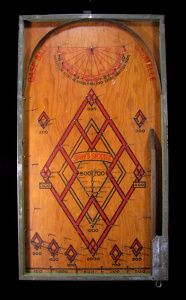
Sharp’s Shooter, from 1932 (Photographed by Guy Harrison)
Advancements in the Bagatelle Era
• The tilt bob was invented by Henry Williams in 1929, and the tilt penalty with it, after it became evident people would shake, jostle, and even lift the machine to gain an advantage. He would found Williams Electronics, which would continue to make pinball until 1999.
• Contact was the first machine to have an electrical power source and rollover switches. When the ball reached certain spots, it would trip a switch and the machine would buzz briefly.
• New ideas for the coin mech were constantly being implemented to thwart people who tried to put in the wrong coins or non-coin objects into the machines.
• Bagatelles eventually had their own legs. Prior, they were placed on tables. This may be where the word "table" came from in regards to pinball machines.
• Gobble holes got started here, though for bagatelles, they tended to be worth nothing, as the idea is to leave your ball visible somewhere.
Woodrail (WR) or Wedgehead - 1931 to 1960 - Pinball got its most defining aspect of its physical shape here: The backbox, a lit box at the back of the machine that displayed the machine's title, some artwork, and most importantly, scoring reels. Due to the time period when these were made, these are sometimes also called "WWII-era machines." Woodrails are named so because the sides of the machine were made of varnished wood, whereas machines made after this would always have metal rails. They are also known as wedgeheads due to the backbox's trapezoidal shape.
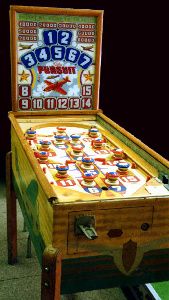
Pursuit, from 1941 (Photographed by M. Milligan)
Advancements in the Wedgehead Era
• The invention of the scoring reel meant players no longer had to count up their scores in their heads or on a piece of paper. Scoring was now automated.
• Enough of the machines were automated that there is now a glass covering over the playfield.
• With advents in keeping track of score and the standardization of electric power, many playfield elements would become common in this era. This includes slingshots, pop bumpers, passive bumpers, spinners, scoops, and drop targets. These playfield elements soon replaced the pins that were ubiquitous in bagatelles.
• The electrical power also meant the introduction of insert lights. This would allow for more complex rules, because they could be used as indicators to the player.
• The flipper was introduced in 1949 with Humpty Dumpty. It had six flippers with their tips facing away from each other. Flippers dramatically increased game time but also radically changed how pinball would be played, and this is where pinball became recognizable as the pinball we see today. Humpty Dumpty proved so popular that older machines were sometimes retrofitted to have flippers. During this era, the flipper layout had not yet been standardized, so there was really weird and wild flipper placement, like a single flipper halfway up the playfield and nowhere else. And yes, this means the tilt sensor was invented before the flipper.
• The same technology that powered flippers would be used for the knocker.
Electromechanical (EM) – 1957 to 1980 – The shift from vacuum tubes to transistors meant pinball could now have processors inside, allowing for more rules and altering game states, such as pop bumpers being worth more if a scoop was reached first. Undoubtedly pinball's golden age, up to 50 different machines were released each year, and pinball machines could be found everywhere, from bars to ice cream parlors to grocery stores to drug stores. Gottlieb reigned as the king of this era, with a new release monthly, which almost always made back their price in people putting coins into them. Pinball machines were so common that operators threw them into the trash when they didn't want them anymore.
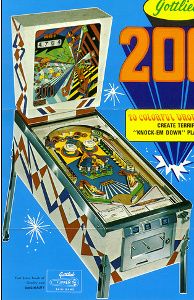
2001, from 1971 (Promotional image from Gottlieb)
Advancements in the Electromechanical Era
• As mentioned above, this era introduced the concept of certain things on the playfield affecting certain other things.
• The processors inside allowed the machine to keep track of simple things, and with that is the end-of-ball bonus. The end-of-ball bonus multiplier was created almost immediately after.
• The extra ball and the special was introduced during the early parts of this era. During then, because of the redemption system, specials were of greater priority than extra balls.
• The frame holding a pinball machine together shifted from wood to metal, which proved stronger and more resistant to wear. They could also be bent, which gave rise to the legs being slightly angled apart from each other for stability.
• Multiplayer was introduced in this era and became a sensation. Due to gambling laws and their exact wording, for some reason I don't fully understand, certain machines had single-player versions and multiplayer versions.
• Multiball was created in this era, now that they could program in multiple game states. It was rare, however.
• Without the autoplunger, the invention of the multiballalso necessitated the lock.
• The standard flipper layout crystallized in this era, with two flippers at the bottom with their tips facing each other, two inlanes, two outlanes, and two slingshots.
• Stand-up targets made for a cheap and low-maintenance alternative to drop targets.
• Rollunder switches and star rollovers made it possible to put switches where it was impossible before.
• Sometime during this era, I'm not sure when, the machine would automatically place a ball onto the plunger after you drain. Prior, plungers had an extra rod-like button you'd shove into the machine to load another ball.
• Captive balls started appearing here, and many variations and rather creative reworkings of the captive ball popped up around then.
• The kickback got started here. Williams didn't yet trademark the term, so every company could call it that.
• Superior manufacturing equipment allowed designers to cut metal and plastic precisely enough to make lanes, loops, and orbits.
• This was the era in which Roger Sharpe proved in court that pinball is a game of skill, overturning New York City's ban, and started the skill shot.
• Nails were installed into the bottoms of some machines to discourage bang backs. Later in the EM Era, manufacturers stopped doing that because they became safety violations.
• Replay scores came about in electromechanical machines. They were fixed, but the operator could adjust it.
• Processors at the time weren't very powerful, but they could at least still keep track of the three-switch rule.
• Nolan Bushnell, best known as the man behind Pong, invented the widebody pinball machine, whose playfield is slightly wider. This allows for more things on the playfield, but requires stronger flippers and is more expensive to build. Widebodies were not popular during the EM days.
Solid State (SS) or Alphanumeric – 1978 to 1992 – At this point, video games had slammed into the arcade market with the force of a meteor, producing hits like Pac-Man and Donkey Kong, driving pinball out of its golden age. Pinball would have to advance and adapt to survive, and with computer technology becoming small and inexpensive enough to be installed onto pinball machines, the Solid State Era began. Pinball's silver age occured right in the middle of this era with Space Shuttle, which would become a big hit and carry pinball as a viable game at the arcade into the following era. However, the one-a-month model no longer flew as pinball was no longer the only source of electronic gaming. Instead, companies released only a few games with a tentpole system and longer development cycles. Some people say that we haven't really left the Solid State Era, as pinball machines up to this day continue to use solid state technology, and many of the core concepts of modern pinball started in this era. (Avoid using its abbreviation in Germany.)
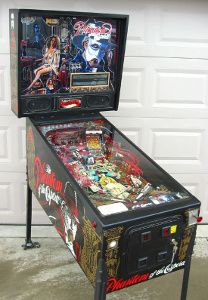
Phantom of the Opera, from 1990 (Photographed by Allen Shope)
Advancements in the Solid State Era
• The computerization of pinball machines meant they were now able to store memory. One of the first things done with this was pre-recorded audio and background music. It required four processors to handle roughly 10 seconds of audio, but hey, they just got started, and video games didn't have pre-recorded audio yet. As memory capacity and processing speed improved, full sentences could be placed into the machines, and the callout was born.
• The increased processing speed meant the game could now keep track of all playfield elements at once, giving rise to the playfield multiplier and the frenzy mode.
• The industry switched from scoring reels to alphanumeric displays, which is what gives this era its other name. This allowed scores to reach higher point values and for the machine to display letters in addition to numbers, thus allowing for short messages or other things.
• The alphanumeric display subsequently gave rise to an increase in the scale of points. Scores were measured in thousands, tens of thousands, or hundreds of thousands in the EM days. In the solid state days, scores grew into the millions or tens of million.
• The match sequence was created in this era, as the machines now knew what your score was instead of just blindly turning wheels.
• Because it knew what your score was, this freed up any limitations on point values for things. Prior, when you got points for doing things, the machine could only keep track of one thing at a time, effectively not allowing you to score until the reels stopped. This is why bumpers were always worth 10, 100, or 1,000 points in electromechanical and woodrail machines. Because the pinball machine was now adding points like a calculator, anything could be worth any amount of points the designers felt like.
• Xenon popularized the ramp to where it became unusual to not see at least one ramp.
• The wizard mode was created for Black Knight. The idea of reaching a climactic end was quickly adopted and copied by everyone else. This gave rise to the popularity of playing a pinball machine to progress towards its endgame. Not all machines released after Black Knight got a wizard mode though. Not even close to all of them.
• Space Shuttle revitalized the sagging pinball business. Its draw was a scale model of a NASA space shuttle placed onto the playfield, thus inventing the "toy." Space Shuttle didn't restore the business to that of the EM days, but manufacturers were satisfied.
• It didn't take long for toys to be moved down to where the ball could interact with it. This led to the most popular bash toy, Rudy from FunHouse, a living marionette who, while harmless, is a big jerk and likes to mock the player.
• Improved manufacturing equipment allowed for upper playfields and under-playfields. Split-level playfields were also invented, which have a raised upper half.
• This increased complexity also made the widebodies more popular, as some designs could not work with a standard-width machine. Designs with upper playfields and under-playfields in particular tended to be widebodies due to the additional playfields taking up so much space.
• Games were reduced from 5 balls to 3, probably because ball times got a lot longer with an emphasis on control and aim rather than luck.
• Tilts no longer end the game, but just the ball with no end-of-ball bonus. In its place is the slam tilt.
• End-of-ball bonuses now had a minimum value. Otherwise, there'd be no deterrent to tilting.
• The alphanumeric display's ability to display letters made "Warning" and "Danger" messages from nudging possible.
• Multiball was invented in the EM Era, but it became common in the Solid State Era, to the point where Cyclone got a lot of flak when it was released because it didn't have one. You also now had additional purposes to multiball like increased scoring, whereas prior it was just having multiple balls at once. Mutiballs were generally reserved for having accomplished everything asked of you though, meaning multiballs and wizard modes were often synonymous.
• The motorized target bank first appeared during this era.
• The autoplunger got started here. This was probably the reason for the sudden popularity of multiball, as it allowed any additional balls to be launched when needed.
• Williams Electronics was incredibly active in trademarking terms and patenting pinball technology. This would limit its competitors' ability to design machines. Not really an advancement, but something that explains a lot of why certain things fell out of favor during this time.
• Without an interesting use for spinners, their importance to gameplay greatly diminished in the 80's. They would typically pertain to only one mode, is just there out of legacy, or to simply as a way for the player to get lots of switch hits at once. There are exceptions here and there though.
• Gobble holes fell completely out of use here. They were rare during the EM days, but people quickly grew to dislike losing your ball for any reason.
• The flipper length became standardized to 2 1/4 inches. This was a size optimized for flipper techniques, though cradling the ball was not a widely-practiced technique until lateer.
• Video games becoming the dominant sight in arcades resulted in a few bizarre hybrids of video games and pinball, such as Granny and the Gators and Baby Pac-Man. None of them caught on, however.
• Replay scores were now dynamic.
• The solid state era introduced free play machines.
• Extra balls became more commonly earned than specials, as specials no longer had redemption value. The requirements to reach a special became harder too, as operators wouldn't want you getting more credits the more you play.
• Random awards were introduced in this era, as the computers inside allowed for randomization. And assigning many possible values and non-points awards to a single location.
• The computers' ability to save data also led to the high scores charts. Originally, only the top score was displayed, but after a few years, it became the standard Grand Champion and High Scores #1 to #4.
• Status Reports became a thing in this era, as the displays could now depict whatever letters, numbers, and simple punctuatino marks as needed, and the rules became complex enough that they couldn’t all be written on the machine. Status Reports preceded video games that displayed information when paused.
Dot-Matrix Display (DMD) – 1991 to Present, Possibly 2016 – The alphanumeric displays of the 1980's soon gave way to the dot-matrix displays of the 1990's. A dot matrix display is a grid of small lights that, when viewed from a distance, can create text or pictures. This shifted notifications to the player from the textual style of the Solid State Era to the more visual style of the Dot-Matrix Display Era. It may be coincidential, but the rise of DMDs also seemed to give rise to a steep increase in the complexity of rules. Maybe it's because DMDs can show many different things at once? Despite the new flashy DMDs, they looked like a relic compared to the 3-D graphics video games were now able to do, and the industry shrunk until it was nearly destroyed. Gottlieb went out of business in 1995, SEGA sold off its pinball division to a small startup in 1999, and Bally and Williams called it quits in 2000, leaving this new startup, Stern, as the only manufacturer of pinball machines by 2001. Stern would deflect the final nail in the coffin and slowly but surely removed its lid, however, and became a thriving business, though not that large, up to the present day.
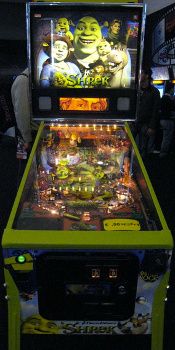
Shrek, from 2008 (Photographed by Federico Croci)
Advancements in the DMD Era
• Some of pinball's top sellers were from this era, most notably The Addams Family, Terminator 2: Judgment Day, and Jurassic Park. The release schedule was now much like with video games (both arcade and console): Have one tentpole release per year with everything else hopefully good enough for operators to like. Said tentpole release was always a licensed title based on a movie or TV show with the actors themselves recording lines just for the pinball machine. This was best exemplified via Star Trek: The Next Generation, which got every single actor for a main character, and a lot of villains and minor characters, to voice the machine.
• The Addams Family, while it didn't create the mode, standardized mode progression: Random selection, a fixed location where they begin, and the wizard mode becoming available once all of them are played. They are also all spelled out for you in the middle, so you know exactly what you've gone through and what you still need to do.
• The Addams Family allowed you to stack modes, and while some machines segregated modes to one at a time, like South Park, people took a real liking to stacking to where some games, like Bram Stoker's Dracula, were centralized on stacking (with its "Multi-Multi-Multiball," which needs no further explanation).
• The ball saver became a standard during this era.
• There was a sharp increase in licensed machines. No surprise considering those three titles I mentioned above were all based on movies.
• The DMD's visual nature allowed the video mode to take off. It had a good start in Terminator 2, but the blunt truth is that pinball designers are not video game designers, and most video modes were frustrating to play. Even during their heyday, video modes were treated as a novelty, and Doctor Who is the only machine I know of where video modes were required to progress. Video modes still exist today, as recently as 2015's America's Most Haunted, but are rare.
• Coin mechs became standardized to accept dollar bills. Well, in the 2010s at least.
• New Canasta experimented with magnetic induction rollovers. It didn't work as planned.
• Lasers were now cheap enough and low-power enough to be put into pinball machines as opto switches. With the advent of the opto, there was now no place where you couldn't put a switch.
• PAPA and IFPA, organizations that run competitions, were founded during this era. A result was that pinball machines were now being geared towards competitive play, such as game balance and tournament settings options like a fixed order for random awards.
• The virtual lock was made during this era, possibly as a response to the growing competitive scene and the complaints around "lock stealing" (see that definition under "Competitions," or not as it's pretty obvious what that means).
• Games started recognizing death saves. A few, such as The Adventures of Rocky and Bullwinkle and Friends, acknowledged them and rewarded the player. A few, such as Jurassic Park, deducted points instead.
• As part of a response to the industry sagging again through the mid-90's, scores were inflated again to try to entice newcomers. This is when it got out of hand, with high scores reaching into the hundreds of millions, billions, and even tens of billions. Stern set a general ballpark of hundreds of millions.
• Prior, machines needed a separate row of displays (whether scoring reels or alphanumeric displays) for each player. The DMD freed that, and SEGA allowed up to 6 players per machine. Things settled back into the usual 4-player maximum after a few years, however, because having 6 people to a machine created issues in waiting.
• Multiballs stopped being the end goal and were now modes you could more easily begin. For the most part, the wizard mode became a grander, more epic-feeling multiball. This may have been another change invoked by The Addams Family, where multiballs were a big deal but not the ultimate goal. Later on, games would have multiple multiballs. The Sopranos has Stugots Multiball and Bad-a-Bing Multiball, for instance.
• Because multiballs were now found in the middle of progression rather than the end, jackpots and super jackpots became the domain of multiballs rather than a flat-out reward. The phrase "add-a-ball" changed from a mechanic related to extra balls to one related to multiballs. Stern created a standard of always making add-a-ball available in the first multiball after you start playing, though it was not always easy to earn.
• The ability to display images or text at whatever size is needed allowed designers to always display the ball number, player number, and number of credits left onscreen at all times, as well as the replay score. It also allowed for the collection mechanic, as you could now visualize that the way video games can, whereas it would've been cumbersome to spell it out with alphanumeric displays.
• Increased memory storage let pinball machines get patched and updated. Originally, you'd download them onto physical storage, bring them over to the machine, and plug it in. The newest ones can connect online to receive patches and updates directly through download, but they can still be installed via USB.
• The idea to cradle the ball spread among pinball players during this era. Designers responded by increasing the difficulty and greatly increasing the quantity of timed modes. Rules were also implemented to prevent people from stalling via cradling the ball.
• The widebody reached its most popular during the mid-90’s, with Williams’s “SuperPin” line, a widebody released once per year. They were incredibly hyped and consistently sold well, to where operators blindly pre-ordered them knowing they couldn’t be returned, as they would always turn a profit—until Popeye Saves the Earth, which had confusing themes, mismatched artwork, obtuse rules, and an upper playfield that blocked the view of entire back half of the main playfield. Said trust was shattered practically overnight, and pinball went on a decline that got the industry scrambling, which led to…
• …The Pinball 2000 line, appropriately created in 1999-2000. It implemented a monitor, whose reflection would be overlaid onto the playfield glass. Usage of this monitor was basic at best, and because it took up over half of the view to the player, everything was centered around the monitor and gameplay was repetitive. In addition, the monitor was a CRT hanging upside-down. CRTs are really heavy. Bally and Williams closed their pinball divisions after one game each from them (Revenge from Mars with Bally, Star Wars: Episode I with Williams). The mixed opinions on them may be a contributing factor to the mixed reception of the Monitor Era, which I’ll discuss right below.
Monitor? – 2012 to Present – Though this era’s existence is in dispute, I would consider it a new era. It’s still too new to have any major advancements in how pinball is played, with changes instead to the industry’s structure and replacement of old technology with new technology. There was a boom in startup companies that has fizzled out somewhat, but some companies, like Silver Castle and Elwin Bros. Company, have yet to release their first games. Curiously, the monitor’s reception is mixed, with some companies, like Spooky Pinball, creating something in between: A full-color monitor with the small narrow dimensions of a DMD and the pixelation to simulate a DMD. I mentioned before that pinball designers are not video game designers, and currently, usage of full-size monitors has been clumsily implemented, which I believe is the reason behind the lukewarm reception to them. Nevertheless, monitors are real eye-catchers, and they command the attention of casual players. They also help make a pinball machine actually look modern—one look at The Wizard of Oz and you can tell this was made in the 21st century.
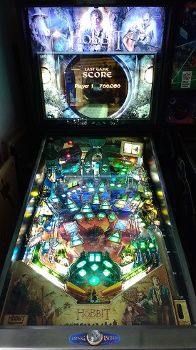
The Hobbit, from 2016—Jersey Jack ran far behind schedule (Photographed by Martin Ayub)
Advancements in the Monitor Era
• Decreasing prices in LEDs, as well as the gradual phasing out of incandescent lights by the United States government, meant pinball machines are now lit with LEDs rather than incandescent lights. This has been a controversial move, as there are a lot of purists who detest the light emitted from LEDs.
• With arcades an endangered species, the market for home use in North America has overtaken pinball for public use. That is, over half of all sales of pinball machines in North America are going into people's residences for them to play all to themselves. You think a US$600 PS4 is expensive? These people pay about US$6,500 for one game, and up to US$26,000. This has affected how pinball machines are marketed, with a shift away from promises for good earnings and attention-grabbing devices to gameplay mechanics and depth. (Most operators do not play pinball, so the marketing had to show things they would understand.)
• The P-ROC system and the Multimorphic system have encouraged homemade pinball. A result is an explosion in startup companies making pinball machines, to varying levels of success (usually complete and total failure before their first game even comes out, the most notable case being veteran designer John Popadiuk Jr., whose mismanagement and secretiveness financially ruined him). Most of the remaining manufacturers are referred to as "boutique," who make small runs of very expensive but very high-quality machines (we're talking US$10,000 at minimum).
• The ubiquitousness of wireless networks means some machines can display global leaderboards. You can also play multiplayer with someone far away.
Competitions
Yes, competitive pinball is a thing, and there are a few terms specific to competitions helpful to know if you’re ever in one or spectating one. To win a competition, all you have to do is put up a higher score than the other participants. That’s all there is to it. Doing so, obviously, is easier said than done. It helps if you have read the “Multiplayer” mechanic above, as almost all tournaments utilize that to one degree or another. And if you’ve been in competitions before, you may be familiar with some of these terms already.
Professional and Amateur Pinball Association (PAPA) – The central organization monitoring and tracking pinball competitions in North America. They’re also the go-to group for pinball-related media, regardless of where in the world it is, and provide rulings, banlists, and free tutorials. Headquartered in Pittsburgh, PA. http://www.papa.org
PAPAtv – The department of PAPA in charge of self-made media, putting videos on YouTube and Twitch TV. PAPAtv is also in charge of tournament footage. During off-seasons, PAPAtv provides tutorials and demonstrations of specific games hosted by Bowen Kerins, and whenever they feel like it, a weekly video podcast called PAPAtv Live, where local players play games on reserve with commentary. https://www.twitch.tv/papatvpinball
International Flipper Pinball Association (IFPA) – The dominant pinball tournament organization for the rest of the world, although they, too, are located in the United States. The IFPA’s other main purpose is to revise rules and create experimental new tournament formats. Headquartered in New York City. The IFPA and PAPA frequently collaborate, and most major tournaments in North America are affiliated with both. http://www.ifpa.org
Tournament Director (TD) – A person who organizes and/or supervises a competition. A tournament director decides and enforces his or her tournament’s rules.
World Professional Pinball Rank (WPPR), often pronounced as Whopper – A points-based ranking system created by the IFPA and shared by PAPA. You gain points by doing well and lose points for doing not-so-well, and the amount gained or lost is directly proportional to the number of participants. Your international ranking is based solely on your WPPR score. This system encourages very competitive players to travel around North America, or even the world, entering as many competitions as possible and raise their WPPR scores as high as they can.
Circuit or Season – The set of major tournaments covering the period after a PAPA or IFPA World Championship to the next PAPA or IFPA World Championship. Usually, this is 12 months, but there are exceptions. Due to the WPPR system, the top-ranked players are pressured to enter as many events in the circuit as possible. The PAPA structure keeps the number of major events at 12 (there is no limit to minor events). There is no hard limit for IFPA.
Game Bank – The group of pinball machines available to be played at a competition. There can be multiple game banks in a tournament, but you can only play in one game bank at a time, and only in game banks you are qualified for.
Herb Style or Pump and Dump – A tournament format where participants pay per game. There is usually a quantity discount. In such a tournament, there’s no cap on how many games you can play, as long as you’re willing to shell out the cash for it and there is still time to play. Your best score is recorded for each game you’ve played at least once, and this is the basis for your standings in the tournament. You may select which game you’d like to play, and if someone is already at that machine, you’re placed at the end of the queue. All games in Herb Style are single-player.
Ticket – Can refer to one of two things: Either a tournament format where each participant plays a fixed number of games for the preliminaries and no more, OR a tournament format where each participant must play a series of games and is ranked based on his or her performance for the entire bunch but can play multiple series. For the latter, whatever is the player’s best set is what determines that player’s standings in the preliminaries. In other words, it functions like a Herb Style competition, only multiple games are treated as one. The former is the prevailing tournament style in Europe, and the latter is commonly seen in top-level North American tournaments. In both cases, the word “ticket” refers to how in these competitions, each participant is given a strip of tickets (like you’d find at a carnival), and one is surrendered to a tournament official for each game played. Like with Herb Style, you may select which game you’d like to play, and they are also always single-player.
Three Strikes – A tournament format that, unlike the Herb Style or Ticket formats, are played only via multiplayer. You are assigned a random machine and a randomly selected opponent. Whoever has the lower score when the game ends is given one strike. If you receive three strikes total, you’re eliminated from the competition. A Three Strikes competition continues until only one person remains who has not yet received three strikes. In essense, this is a triple elimination style with no loser’s bracket. This is a relatively new format, having only become popular in 2013.
Pingolf – A novelty format. Players are given a goal, specific to each machine, such as a particular score or starting a mode. The number of balls needed to reach that goal is the number of “strokes," and the score for that game is the number of strokes minus par, just like in real golf. In keeping with the golf theme, pingolf tournaments most commonly contain either 9 or 18 games. After every player has played every goal, the winner is whoever completed every goal in the fewest amount of strokes. Since some goals might not be reachable by everyone within 3 balls, games at pingolf events are set to either 5 balls or 9 balls. If a player still hasn’t completed the goal, their stroke count is the maximum ball +1. An investigation is currently underway to determine if pingolf can be used as a qualifying round format. (Signs point towards “yes.”)
Pinbowling – Another novelty format. Players are given a target score, usually a high one, and are given 3 balls to achieve it. If done in 1 ball, it counts as a strike. If done in 2, it counts as a spare. If done in 3, it counts as 10 bowling pins. If the player fails to achieve the target score, they have “knocked over” a number of bowling pins equal to the ratio of their score versus the target score, rounded down. Pinbowling scoring is calculated the same way as regular bowling. (This is already horrendously long as it is, so I won’t go into bowling scoring.) This is such a new thing that it has only been put into practice at two competitions as of the time I’m writing this, and the IFPA will investigate this one once it provides an official ruling for Pingolf.
Division – A group of participants belonging to a particular category. PAPA and IFPA assign players by ranking, with the top 300 ranked players belonging to the A Division, and players below that in the B, C, and D Divisions. You may sign up for a higher division than you belong to, but not lower. In major competitions, each division has its own game bank. Some competitions also have a Women’s Division and a Junior Division, who share a bank with a letter-based division. Players can move up or down letter divisions if they prove to be outliers within their division.
Qualifier or Qualifying Rounds – The elimination rounds of a pinball competition. Herb Style, Ticket, and Three Strikes are all types of qualifiers. IFPA rules do not allow those styles to be used for the final rounds. When Three Strikes is used for qualifying, the standings are determined by how many games each participant has played before getting eliminated (with the person left standing in first place).
Cutoff – The lowest standing a competitor can have without being eliminated. People at or just below this line tend to be very competitive and spend lots of money. Three Strikes competitions, obviously, don’t have a cutoff.
Finals – The rounds after the elimination rounds have ended. IFPA rules say that they must be multiplayer games. Each round consists of each player playing four games. If there are 4 players, a top score in a game is worth 4 points, a second-best score is worth 2 points, a third-best score is worth 1 point, and a worst score is worth 0 points. 3 players uses a 3-1-0 scheme, and 2 players uses a 1-0 scheme. After these four games, the players in the top half of points scored moves on while the others are eliminated. If there are 3 players, only the top performer moves on. If there is a tie for points, there is a fifth tiebreaker round played by the tied players, played on a randomly selected machine, determined by that game’s raw score. When 4 or fewer players remain, the final round is played like the previous rounds, except that only the person with the most points remains.
Walk-Off – If you go last in a multiplayer match, it’s the last ball, and you still have the highest score, you can simply plunge the ball and walk off to win, hence the name.
Pot or Prize Pool – A cash prize given to winners that increases directly proportionally to the amount of money put into the competition. Due to the nature of Herb Style competitions, their cash prizes almost always works like this.
Driving the Bus – A privilege during the finals in which whoever receives the highest score in a game is allowed to either pick the next game or decide the order the players will go in, with the other choice being randomly decided by the tournament organizers.
Lock Stealing – The act of taking a previous player’s locked balls. This tactic is considered unfair by the tournament scene, particularly for whoever goes first, as that player alone is unable to steal locked balls. Virtual locks are preferred due to how the machine keeps track of each player’s quantity separately. Machines made from 2006 and onwards either have only virtual locks or the option to convert physical locks into virtual locks. Separate competition rules are made on a case-by-case basis for machines with physical locks but no virtual locks. This can range from playing only in 1-player mode, installing something to block the ball from reaching the locks, or banning the game outright from competitions.
Elwin Maneuver – Holding all balls in a multiball on one flipper except for one, which is held on the opposite flipper. This allows you to play even a frantic multiball at the pace you want without worrying about the other balls draining, albeit at the cost of the use of one flipper. In a competition, when a multiball begins, people will immediately try towards this formation. For most people, even top-ranked players, it is not easy, but for Keith Elwin, it’s a breeze, which is why it’s named after him. (There is a reason he is a three-time world champion.) Another benefit to the Elwin Maneuver is that, if you DO lose a ball during a multiball, you can continue playing with the other balls trapped on the other flipper. Ideally, you use a flipper pass to send one ball over while keeping the other ball(s) still held.
Usage – This has the exact same definition as “tiers” in fighting games. (As there is extremely little crossover between fighting game fans and pinball fans, the word “usage” was developed independently without the knowledge that an equivalent term has long been in use by fighting game fans.) A few machines released within the last few years, like AC/DC and Game of Thrones, ask the player to pick something at the beginning, which affects the rules and adds certain mechanics exclusive to some selections. As a result, how you play the game differs in particular ways depending on what you selected, with some being more viable choices than others. An example is House Lannister in Game of Thrones, which allows you to acquire more Gold than other houses and lets you purchase things to help you sooner. Problem is that these things aren’t that effective and the shop is rarely open, relegating Lannister to bottom-usage and rarely chosen in tournaments. By contrast, House Martell invokes a permanent combo multiplier in one of the inlanes, and you can pick which inlane it is. If you’re good at shooting combos, you can get up to a x5 bonus on every shot. Make an important shot with a x5 multiplier and you’ve got it in the bag. A result is that House Martell is top-usage and the most-chosen house. Bear in mind that, like with fighting game tiers, usages are sorted with top-skilled players in mind. That combo multiplier won’t do you much good if you have bad aim, for instance, and you won’t feel like House Martell is top-tier material unless you’ve been playing pinball vigorously every day for years.
Pinburgh – A competition set at Pittsburgh Convention Center. This is PAPA’s biggest event by number of attendees. Considered the holy grail of people who want to visit pinball tournaments, and veterans schedule vacations several months in advance in order to be here. Pinburgh is most commonly set between September and November.
ReplayFX – A general gaming convention, held in Philadelphia. This is the biggest event where there is a PAPA competition, but it’s only one of many different things here. ReplayFX is always set between late July and early September. http://replayfx.org/
Pinball at the Sanctum – A 24-hour competition held at The Sanctum in Boston, MA (I believe). Entrants are required to play the full 24 hours, making it a test of endurance and alertness. Each round begins whenever the last game in the previous round ends, and there is no second warning. All games are 4-player, with empty slots as needed. There is no elimination, and players receive points based on their position in each game. You get 1 point for placing last but 0 points for a no-show, and this has allowed people who can stay alert the whole 24 hours to pass ahead of more skilled players who can’t hold up for that long. Currently, Pinball at the Sanctum is not a PAPA or IFPA Circuit event, and it’s treated as a novelty.
And that’s about it. It was quite an exhaustive list, and I’m surprised this place can hold a message this large. I may add more to this later, such as the Over Under Separation technique and categories for Creators (covering both companies and key individuals in the industry), but I've already been at this for two weeks.
Overall, pinball terminology is amazingly straightforward, with very few terms taken from memes, references to players and incidents, or terms taken from specific games. This is likely due to pinball having been around before terms as references became popular, and most of these terms I'll tell you have been around since at least the 1950's (though they didn't all yet solidify as universal terms), with the exception of the Mechanics category.
(Bear in mind that I am referring to physical pinball machines here. There are plenty of virtual ones out there that don’t necessarily follow the same rules.)
Objects
By "Objects," I'm referring to the physical parts of a pinball machine. To keep things simple, I'll only talk about objects visible to the player or otherwise directly relevant to gameplay. These terms are in order of importance to pinball. That is, the closer they are to the top, the harder it is to talk about pinball without knowing these terms, the exception being groups of related terms (because I put them together). I'll also provide a picture of each of these objects to give a clearer idea of what they are.
Playfield - The big board containing all the devices listed in this section. With a few exceptions, an entire game of pinball will be set on this playfield and the objects attached to it. Playfield surfaces are made of layered wood, with the exception of New Canasta, which is made of PVC plastic, though things attached to the playfield can be made of anything (most commonly plastic and metal).

A playfield of Cross Town (photographed by Raphael Lankar)
Ball (object) - The metal ball. I'm sure you already knew what this is called. A standard ball is 1 inch in diameter and is made out of an alloy containing 90% iron and 10% chromium to minimize rusting, dulling, and wear.

A ball in action in Congo. Keep your eye on the ball! (Photographed by Al Kuester)
Flipper - A small plastic bat, used to propel the ball upwards when swung. Flippers are under direct player control and, in most pinball machines, the only thing under direct player control. Ever since the 1950's, it has been standard to have at least two flippers, placed near the bottom of the playfield and facing each other with a gap in between. Some machines have 3 or more flippers. Two buttons are located on the sides of a pinball machine near the front corners, one on each side. The button on the left, when pushed, swings all flippers whose pivots are on the left, and the button on the right does the same for all flippers whose pivots are on the right. Flippers are also lined with rubber so the ball is bouncier when it hits a flipper.

The bottom flippers in Super Mario Bros. Gottlieb liked to puts its logo on its machines’ flippers. (Promotional image from Gottlieb)
Lightning Flipper – A special type of flipper that’s yellow and has a picture of a lightning bolt on it. Lightning flippers are 1/8” (3 millimeters) shorter than a standard flipper. Some games come pre-installed with lightning flippers, but more commonly, lightning flippers are used as a replacement for a pinball machine’s normal flippers to increase its difficulty. It might not sound like much, but pinball machines were designed with the standard 2-inch flipper length in mind, and even a novice will notice the game being harder.

Both lightning flippers from Fish Tales. Notice the lightning bolt design on them. (Photographed by Billy van der ven)
Plunger - A spring-loaded metal rod with a rubber tip installed onto the bottom-right of a pinball machine. You pull the handle back and let go, and the rod will snap back, sending the ball rolling. Balls begin on the plunger, and you launch it into the game whenever you're ready to start playing.

The plunger in Torpedo Alley. Pull that thing back and start the game! (Photographed by Ken Fitzhenry)
Autoplunger - A button-based plunger. Instead of pulling it back manually, you just push the button and it launches the ball. Autoplungers are also used in games that, during certain circumstances, automatically launch a ball without input from the player. Hence, some games have both a manual plunger and an autoplunger. Autoplungers are most commonly a big button where a plunger handle would normally be, but they can take different shapes, such as the handle of a gun as seen below.

An autoplunger shaped like a gun from Batman Forever. You pull the trigger to launch the ball. Apparently, SEGA wasn't concerned with how Batman doesn't actually use guns. (Photographed by Allen Shope)
Insert, Light, or Lamp - A light placed underneath the playfield, with colored clear plastic overhead to create a flush surface where you can see the light below. These were once incandescent lights, but LEDs are an industry standard now. Inserts are used to indicate things to the player, alerting the player to certain game states depending on if the light is off, is on continuously, or blinking. All pinball machines made after World War II have inserts, and usually a lot of them. Even primitive electromechanicals (see "History" below) will have dozens of these lights scattered all over the playfield.

A bunch of inserts in Pirates of the Caribbean. Notice that some of them are labeled directly onto the plastic, while others have their labels to the side. For now, don’t worry about what all these mean. Just know that they’re alerting the player to certain things. (Photographed by Martin Ayub)
Coin Mechanism (commonly abbreviated as Coin Mech) or Coin Acceptor: The device at the front of the machine that takes coins. Some modern ones take dollar bills, and some operators install a card reader in its place.

A coin mech from Cyclone (Anonymous)
Switch – A device used to indicate a ball has reached or passed a particular location. If it can detect the ball’s location, or its activation means the ball has been there, it’s a switch, regardless of what it physically is. Any detection of the ball at a switch’s location is a ”switch hit.” The following 13 definitions are all either types of switches or contain switches inside of them. Hence, this paragraph has no picture because it’ll be covered entirely through the following definitions’ pictures.
Rollover – A type of switch that activates as the ball rolls over it, hence the name. Most rollover switches take the form of a slit in the playfield with a thin metal rod curved like an arc sticking out of it. Both ends are beneath the playfield, allowing the rollover to be activated from either side. When the ball rolls over the slit, it presses down on the metal arc, completing a circuit and signaling the machine that the ball has been there. Rollovers are the most common type of switch to detect a ball traveling down a narrow path. There have been a few experimental alternatives that are completely invisible to the player, such as the magnetic induction rollover, but they haven’t been standardized.

A pair of rollovers in South Park (the slits) (photograph by Christopher Wolf)
Star Rollover or Button Rollover – A special type of rollover switch that’s disk-shaped. It has many sloped lines radiating down from the center, which is what gives it its name. Whereas regular rollovers can only be activated if the ball is traveling in a specific line, star rollovers can be activated from any angle. These are used in wide open spaces, but they are more expensive to make, can’t fit in those narrow paths regular rollovers are for, and there has never been much purpose to putting switches out in the open, so they’re rare. Some types are simply a raised circle with no radiating lines; these are button rollovers. (Another reason why they’re rare is because Williams Electronics had a patent on them that only recently expired.)

Two star rollovers from Centaur. These are used in place of rollovers, in this case because they can be placed closer together. By registering the order of activation, the game can determine whether the ball has traveled up or down this path. (Photographed by Mark Steinman)
Rollunder – A type of switch that, as you might have guessed, activates when the ball rolls under it. Also found in narrow paths, rollunders take the form of an arch over the path with a U-shaped thin metal rod hanging down that can swing. When the ball passes underneath, the metal rod will swing back, completing a circuit and, like rollovers, signaling the machine that the ball has been there. Rollunders are mostly used in raised areas and/or surfaces not made of wood, where a rollover would be difficult or impossible to install.

A rollunder switch in The Walking Dead (photograph by Martin Ayub)
Opto-Sensor or Opto Switch (usually shortened to just Opto) – A laser, invisible to the naked eye, that detects when something interrupts the beam’s path when something crosses it. In almost all cases, that'd be the ball. Optos are used in place of rollovers or rollunders where the other switches are impractical or impossible, such as crossing a wide area or a lack of overhead space.

An opto system in TRON: Legacy. See the glowing hole in the wall that the right arrow is pointing to? There's a corresponding hole on the other side, which the left arrow points to, with an invisible laser running between them. Whenever the ball passes through, it blocks the laser, and the game knows the ball has gone by. (Photographed by Martin Ayub)
Pop Bumper, Jet Bumper, Thumper Bumper, or Active Bumper – A mushroom-shaped mechanism that, once the ball comes close, propels the ball away at a high speed. Probably one of the most famous objects on a pinball machine and is known simply as a “bumper” to laypeople. A pop bumper has a metal ring directly underneath its cap. When the ball touches it, it becomes slightly slanted, triggering a leaf switch below. The leaf switch signals the metal ring to slam downwards, pushing the ball away, then reset to its original position as quickly as possible in case the ball returns there. Pop bumpers are rarely found alone and are most often found in groups of 3 in an equilateral triangle. The reason why this device goes by so many names is because each major manufacturer trademarked a name for them. The company presently known as Stern claimed “pop bumper,” Bally-Williams collectively owned “jet bumper” or “jet,” and Gottlieb took “thumper bumper.” “Active bumper” is a generic term, though rarely used nowadays. It differentiates itself from the passive bumper, which does not propel the ball outwards.

A pair of pop bumpers from Liberty Bell. Yes, they can be lit too, usually indicating they’re worth more points. (Photographed by Frank Sansone)
Slingshot – A device that detects the ball touching an outstretched line of rubber that then propels the ball away from it with a horizontally-moving solenoid. Its effect on the ball is similar to that of pop bumpers, except a slingshot’s boundary is a straight line whereas a pop bumper’s is a circle. Slingshots are sometimes found at the perimeter of a playfield, used to create wild and unpredictable ball paths, but about 95% of the time, a pinball machine will have only two slingshots, located directly above the flippers and taking the form of a scalene triangle.

A slingshot from Xenon. Notice the flipper directly below. The pink line I’ve added in indicates the only reactive side of these triangular slingshots—that is, the slingshot will only propel the ball if the ball touches that side. (Photographed by Christopher Wolf)
Scoop – A hole that the ball can fall into. It can be deep enough to completely conceal the ball, or it can be shallow enough for the ball to simply sit in. The shallow ones are sometimes referred to as saucers. After a short time, the ball will be ejected out of the scoop and returned to the player, though in some cases the ball remains there and the player is given another ball. Scoops always contain a switch, obviously, so that the game knows the ball has fallen into it.

A scoop in Scared Stiff (Photographed by Allen Shope)

A saucer in Ghostbusters. It’s shallower than the ball but has a small hole in the middle for the ball to rest safely on. If you look carefully, you can also see some metal in that hole. That’s the solenoid to get the ball back out.
Trap Door – A type of scoop with a flat top that’s normally level with the playfield, allowing the ball to roll over it. When conditions are met, however, it will lift up, revealing a hole the ball can fall into.

It does look like a trap door in Theatre of Magic. When it opens up though, it doesn’t stay open for very long. (Photographed by Christopher Wolf)
Spinner – A small piece of metal or plastic, usually square, lifted slightly above the playfield. This piece is attached through the sides with a metal wire, about the thickness of a paper clip. When the ball passes by, it strikes the bottom of the piece, causing it to spin. Each full rotation of the spinner counts as a switch hit. The idea behind a spinner is that the faster and more cleanly the ball passes through, the more full rotations the spinner will do and thus the player is rewarded more for it. Spinners can be adjusted to spin for a longer or shorter time.

A spinner from The Rolling Stones (Stern) (Photographed by Martin Ayub)
Stand-Up Target – A piece of flat plastic, perpendicular to the playfield, with a leaf switch behind it. When the ball hits it, the impact sends the plastic piece back slightly, completing a circuit and detecting that hit. They are called stand-up targets because, of course, they’re standing up…

A stand-up target from Rob Zombie’s Spookshow International (Photographed by Martin Ayub)
Drop Target - …As opposed to a drop target, which drops when hit. When the ball hits it, it will drop until it’s flush with the playfield, effectively removing it from play and allowing the ball to pass through until the drop target is raised back up to its original position. How long the drop target remains down depends on the rules. Drop targets were actually invented before the stand-up target and were used in the same way stand-up targets are now, but with stand-up targets becoming more common and less expensive, drop targets were then used to block the way.

A drop target in Batman: The Dark Knight, decorated with the face of the movie’s most iconic character (Photographed by Martin Ayub)
Target Bank – A set of 2 or more stand-up targets or drop targets placed next to each other in a row. Most of the time, they are placed side-by-side, but there are a few cases of drop targets placed behind each other, resembling dominoes. These are also known as target banks.

Two banks of 3 stand-up targets each, placed side by side along a wall in Junk Yard. Each bank is next to a fourth but separate stand-up target. (Photograph by Allen Shope)

A bank of 3 back-to-back drop targets in Metallica. The one at the front is down, and the two in the back are still standing. (Photograph by Jean-Pierre Renault)
Motorized Bank – A bank of targets connected together by a motor. When all of them are hit, the motor lowers the targets down simultaneously until they’re level with the playfield, allowing the ball to pass on through.

A motorized bank from Attack from Mars. Once all three of the red targets have been hit, they will all lower together. The red inserts in front of them tell you which ones you’ve hit. (Anonymous)
Captive Ball, or rarely, Newton Ball – A special kind of stand-up target, this is a ball trapped in a small, narrow path. The ball never leaves this path, even when the machine is not being played (except when moving the machine around). The path has a small opening at the bottom, not wide enough to let the ball through but wide enough for your ball to hit it. At the end of this path is a stand-up target—like with a spinner, you are supposed to hit the captive ball hard and clean enough for it to reach the target at the end of its path. Naturally, the longer the captive ball’s path, the harder and more cleanly you have to hit it. Some captive ball paths have rollover switched behind them too so the machine can measure rough distances the captive ball has traveled if it doesn’t reach the end. And while the image here is a straight line, some captive ball paths are curved, and a few even loop around themselves.

A captive ball in Fireball. Hit that ball with your own ball as hard as you can, with enough force to hit the stand-up target at the very back! (Photographed by Matty Kluge)
Gate – A mechanism that resembles a rollunder switch, but it’s not a switch. Rather, a gate allows a ball to pass through in only one direction. If the ball tries to go through the wrong way, the gate will bounce the ball away.

A gate from The Simpsons Pinball Party. The arrow I added in indicates the direction the gate will allow the ball to travel. (Not over the metal wires though.) This gate is sometimes absent though. (Photographed by Marc Alexander)
Lock or Ball Lock – A place or device that stores a ball to be released later. In most cases, certain conditions must be met for the lock to store the ball; otherwise, it will reject the ball as soon as the ball enters it. Physical locks come in two types. One uses scoops and will hold a ball there, and the other has something get in the way of the ball’s trajectory, keeping it there. There is a third type called a “virtual lock,” which I have categorized under “Rules” as it has no physical form.

A scoop-type ball lock in Capersville, with a ball stored on both locks (Photographed by Christian Jacobs)

A queue-type ball lock in The Wizard of Oz, with two balls held here by the metal bars. When they’re ready, the metal bars will lift, releasing the balls. (Photographed by Martin Ayub)
Jail – A special kind of captive ball whose concept is combined with the lock. When a game begins, the jail is empty. If you send a ball in there, however, bars come down (or up, depending on the game), trapping the ball in there. Once there, the ball functions as a captive ball. This ball will be released later, either when you trigger the bars to come down or the game ends, whichever comes first.

The “Link” jail in James Cameron’s Avatar. On the left is the empty jail, and on the right is the same jail with a ball trapped in it. (Photographed by Martin Ayub)
Outlane Post – A metal peg, usually but not always with a rubber ring around it, placed at the entrance to the outlane. Modern machines have easily-removable outlane posts and multiple holes to insert them in, which is a simple way of adjusting a machine’s difficulty. With enough experience, you can judge an operator’s intent by looking at where he or she has placed an outlane post. I will explain the outlane post’s purpose in more detail below in the definition for “outlane.”

An outlane post on Big Buck Hunter Pro, set to its bottom-most position (Photograph by Mike Nogle)
Kickback or Laser Kick – A solenoid found at the bottom-left corner (rarely the bottom-right, as it’s difficult to fit it there). If the ball exits play and passes through this corner, the kickback will send the ball back up and allow you to continue playing. As you might figure, kickbacks are not always active. The word “kickback” was trademarked by Williams when referring to this mechanism. As a result, Data East, the only other company at the time to use them, called it the “Laser Kick.”

The kickback, known here as a Laser Kick, on The Adventures of Rocky and Bullwinkle and Friends. Not visible is that the image depicts a rocket blasting off, upwards and to the right. (Anonymous)
Diverter – A device located at a split in a path that decides which path the ball will take. In The Shadow, diverters are under direct player control, but on all other games, diverters will act automatically according to the game’s rules. Some diverters are long, thin sheets that act as walls that can lift or lower, and some diverters are plastic pegs that stop the ball’s momentum, causing it to drop down elsewhere.

The long curved metal sheet going across this photo is a diverter from Tales of the Arabian Nights. When lifted up and out of the ball’s way, the ball will travel along the path denoted by the blue arrow. When lowered, it functions as a wall blocking the way, and the ball will travel along the pink arrow’s path. (Photographed by Allen Shope)
Toy – Can mean one of two things, or both: 1) A figure of a character or iconic object to the theme, or 2) A mechanism central to the game that is either not seen in any other game or was the first to use it, AND is really big and impossible to not notice. Fans like it best when they fulfill both definitions.

A toy from The Twilight Zone. This is a gumball machine that, once certain conditions are fulfilled, will dispense a pinball. You can also deposit a pinball into it if you like. (Photographed by Jeff Ball)
Bash Toy – The most common type of interactive toy, this is a figure, usually of an enemy, villain, antagonist, or annoying character, that stands on the playfield itself and can be hit with the ball. A bash toy has a sensor built into it that detects when the ball has hit it. Some bash toys raise themselves up do you can hit them, and some bash toys are always present. A few bash toys are of heroes or neutral characters, though. They tend to get snarky remarks aimed at the designers.

In Iron Man, Iron Monger will slowly rise out of the center of the playfield. He’s huge, he takes up a lot of space, and the designers placed him to encourage players to hit him with the ball repeatedly. (Photographed by Federico Croci)
Center Post – A short metal peg with a rubber ring at its tip, placed directly between the flippers at the bottom. Its purpose is to bounce a ball away that would ordinarily head down there. Physically identical to an outlane post, the only difference being its location.

Center post on Spider-Man Vault Edition, circled in cyan. Notice how far below the flippers the center post is--you'd better be sure the ball is heading towards the center post and not something else! (from a promotional image from Stern Pinball, Inc.)
Kicker or Raptor Kick – A solenoid at the end of a dead end that’s pointed towards the flippers. When the ball reaches a kicker’s range, the kicker will activate, sending the ball coming back down towards the player at a high speed.

Circled in indigo is a kicker on Jurassic Park. It is the little white peg within that circle. Once the rollover switch detects the ball, the peg is timed to hit the ball and send it zooming back down. This mechanism is such a defining part of the Jurassic Park pinball machine, due to how it surprises players the first time they see it happen, that it gave the kicker its alternate name. (Photographed by Mark Steinman)
Vertical Up-Kicker, or VUK for short – A solenoid located within a scoop that sends the ball straight up. By this, I don’t mean towards the player, but towards the ceiling kind of “up.” Vertical up-kickers always have something directly above to guide the ball elsewhere, as you don’t want the ball slamming against the glass in the same spot again and again.

A vertical up-kicker from Lord of the Rings, or more precisely, the round gray hole towards the bottom. When the ball lands in it, the solenoid propels the ball upwards across the metal track above. (Photographed by Cassidy Thomas)
Stopper – A retractable cylinder located in the gap between the two bottom flippers, big enough to occupy almost the whole length of this gap. It spends most of its time lowered and flush with the playfield, but when raised, will prevent the ball from draining as long as the flippers are down. A ball can still escape between the stopper and a raised flipper, however. This is considered embarrassing.

The stopper on Space Shuttle. The red circle lifts up when activated (Promotional image from Williams)
Gobble Hole – A hole that ends your ball. It looks like a scoop, but it won’t return the ball back to you. Sending a ball into a gobble hole is usually very valuable, as you’ve sacrificed your ball to it. Because of their game-ending nature, however, gobble holes went out of style in the late 1960’s, never to return.

A gobble hole on Slick Chick. Note the peg directly above it that encourages the ball to go in there. (Anonymous)
Passive Bumper or Mushroom Bumper – A msuhroom-shaped object that has a sensor inside that can detect that a ball has hit it. Unlike pop bumpers, these do not propel the ball away except through the ball’s own momentum, and they are much smaller than pop bumpers. Passive bumpers have no moving parts. As a non-interactive element, they were kind of boring, so they’ve become extremely rare in pinball machines made in the 1980’s and onwards.

A pair of colorful passive bumpers on Gator (Anonymous)
Upper Playfield – A smaller playfield, raised above the main one. An upper playfield usually has at least one flipper of its own. Upper playfields stand out whenever they’re present, so machines with upper playfields tend to centralize around it. Losing the ball on an upper playfield feeds the ball back to the lower one. An upper playfield can have any of the objects listed above, though because of their raised nature, rollover switches and scoops are rare.

An upper playfield from Family Guy. It’s complex enough to be its own miniature pinball machine! (Photograph by Martin Ayub)
Under-Playfield, Cellar, Basement, or Sewers – A smaller playfield, at a lower elevation than the main one. The phrase “lower playfield” is not used because that refers to the main playfield where upper playfields exist, which are far more common than under-playfields. Machines with under-playfields have wide open center spaces in order to contain the window through which you can see the under-playfield.

The under-playfield in Haunted House. Not every under-playfield is slanted away from the player though. Haunted House is notable for having both an upper playfield and an under-playfield, a result being that it was one of the most expensive machines to build of its time. (Photographed by John Kirby)
Knocker – Unless the machine is extremely damaged, you won’t be seeing this, but play for long enough and you’ll hear it (assuming you’re not deaf or hard of hearing). A knocker is a solenoid that makes a loud knocking sound to indicate to you (and anyone nearby) that you’ve won a free game.

I think that’s the knocker on Ripley’s Believe It Or Not!, but I’m not entirely sure. They look like any other solenoid. (Photographed by John Gray)
There are a lot of other exotic playfield elements, but they tend to be found on only a few machines, or even just one, and are only worth mentioning when the tables themselves are being discussed. Examples include the perpetually-spinning automatic flipper in Monopoly, the magnetic slingshots in Ghostbusters, and the red flipper in Starship Troopers, though such elements are mostly classified as toys, which to many pinball fans is a “miscellaneous” counterpart.
Paths
In this category, I talk about things on a pinball machine that can guide the ball in particular paths, hence its name. Any in-depth discussion about pinball will require knowledge of these terms. Like with “Objects,” I will have an image of each of these too.
Drain - The hole at the very bottom of the playfield. You lose your ball if it reaches this spot. You do not want your ball to go down here. This word also exists as a verb; "to drain" means to lose a ball by letting it go down the drain. (Ex. "I only played for 5 seconds before my ball drained.")

The arrow points to the drain in Bowling Queen (Photographed by Russ Jensen)
Lane – A path on the playfield itself that’s slightly wider than the diameter of the ball. Lanes are designed to guide the ball down specific paths, either to an object at the end or back down to the player. So that the machine knows the ball has traveled the full length of the lane, most lanes have a switch at its entrance and another at its terminus or exit.

The entrances to two lanes, side-by-side, on Game of Thrones Limited Edition (Photographed by Martin Ayub)
Orbit or Loop – A lane that takes a curved path and returns the ball directly back to the flippers at the bottom. An orbit is a loop that comprises the outer perimeter of the top part of the playfield but is sometimes called a loop anyway.

Both orbits on Medieval Madness are visible in this photograph, whose entrances I marked with arrows. (Photographed by Allen Shope)
Plunger Lane - The lane that the plunger is in. Balls enter the playfield here and are placed onto the plunger. A game does not officially begin until the ball leaves the plunger lane and enters the playfield at large.

The plunger lane on Pabst Can Crusher. Notice the ball resting on the plunger at the bottom. (Promotional image from Stern)
Ramp – A raised path. The ball goes up the entrance, then travels along the raised path. At the end of a ramp is a hole where it’s dropped off elsewhere, usually an inlane (which, as you can see, is the next definition), but sometimes in the middle of another ramp. On rare occasions, the end of the ramp is an incline downwards where the ball can also enter, but these are rare, and I can’t think of any examples. Ramps have been ubiquitous in pinball since 1987, probably because they allow designers to build over other things. Like with lanes, switches exist at a ramp’s entrance, but the second one is normally at the ramp’s highest point, as it can be assumed once the ball passes the peak, it can make the rest of the trip. Ramps are the most common uses for rollunder switches.

A ramp in Guns N’Roses. Look carefully, and you can see the entire path for the ball to take. (Photographed by Allen Shope)
Inlane or Flipper Return Lane – A special type of lane found at the bottom third of the playfield, traveling behind the triangular slingshots and to the flipper. Since the standard layout has two flippers at the bottom, the standard layout also has two inlanes, one for each flipper. Most ramps feed into an inlane so that the ball can safely travel to a flipper.

The inlanes in Indiana Jones, marked with arrows at each entrance (Photographed by Nile Roberts)
Outlane – Like inlanes, you can find these at the bottom. They are further out than the inlanes, giving them their name. Whereas an inlane feeds to a flipper, an outlane feeds to the drain, so you want to avoid letting the ball go down an outlane whenever possible. On some machines, the left outlane contains a kickback, which sends the ball back up and back into play. A few machines have alternate ways to save the ball too. At the entrance to each outlane is an outlane post (which I defined up in “Objects”). Modern machines allow you to adjust the position of the outlane post within a small range, effectively controlling the width of the outlane’s entrance. Although you’re only moving it by a few millimeters, this dramatically affects the ball’s likelihood to enter the outlane. Particularly cruel operators can also remove the outlane post completely if they don’t mind getting punched in the face.

The outlanes in No Good Gofers, marked with arrows at each entrance (Photographed by Christopher Wolf)
Tunnel or Subway – The inverse of a ramp, a tunnel is a path that takes the ball under the playfield. The ball falls into a scoop-like hole, then emerges out from another hole. Tunnels require a good strong solenoid at the end of the path that can chuck the ball back out.

Although it’s not visible, this is an approximation of a tunnel’s path in The Addams Family. Get the ball behind the blue bookcase at the top, and the ball will emerge out of the swamp below. (Photographed by Allen Shope)
Techniques
Now that you can identify most things on a playfield, we're going to talk about techniques players use. Pinball has a reputation for just using the flippers and praying the ball bounces to where you want, but in reality, experts have tight control over the ball, and in doing so, also control the pace of their play. That’s the secret to their success. Over the decades, players have developed a lot of different ways to not drain. Some of these are illegal to use in competitions; those will have a ILLEGAL! tag.
By the way, all of the diagrams I use begin on the left side. For every technique except for the Death Save, they can also be mirrored if you begin on the right. And yes, all of them are possible. I’ve done all of them except for the illegal maneuvers. I’d prefer to have a recording where I perform them, but I can’t really film it without the camera getting in my way.
Shot – A use of the flipper by the player to propel the ball. The verb form of this, of course, is “to shoot.” Sometimes, a use of the plunger to send the ball into play is also called shooting, but if the words “shoot” or “shot” are used without context, it refers to using a flipper. Aiming your shots so they travel in the direction you want is key to doing well.

Soft Plunge or Controlled Plunge – This is when you launch the ball from the plunger without pulling the knob back all the way. Naturally, this can only be done on machines with manual plungers. Soft plunging is used for if you want to begin your ball somewhere other than where it’ll go with a full plunge. On some machines, soft plunges are recommended as they bring the ball safely to a flipper rather than wildly bouncing around somewhere else.

Cradle, Trap, Catch, or Hold – An absolutely fundamental skill to play decently, cradling is the act of keeping a ball trapped on a raised flipper. You see, when you hold the flipper button, the flipper stays up. If the ball has low enough momentum, it will stop before it reaches the tip of the flipper, allowing you to keep the ball there for as long as you’d like. While doing so, you can plan which shots you’ll make. And since the ball is at a known fixed speed (that is, stopped), you can let go of the flipper and time your shots to be more accurate.

Flipper Pass – An act of using a flipper to send a cradled ball from one flipper to the other. Some shots are more easily done from one flipper to another. There are two types of flipper passes.
Post Pass – This flipper pass is done by shooting the ball at the bottom-most corner of the slingshot on the opposite side. The post making up that corner will absorb the ball’s momentum, allowing you to catch it on the opposite flipper.

Tap Pass or Flick Pass – This flipper pass is done by letting go of the flipper button for just an instant, allowing the flipper to go down a tiny amount, then pressing it again, sending the flipper back up. The small distance the flipper has traveled going up means it imparts only a small amount of energy onto the ball. If done right, this will allow the ball to gently and slowly arc over to the other flipper.

Dead Pass, Bounce Pass, or Dead Bounce – If the ball is coming down towards the wrong flipper and you think it’s the right speed, you can simply do nothing and let the wrong flipper’s rubber bounce the ball to the right one. While you need good judgment of the ball’s speed and the machine’s steepness, friction, and flipper angles to consistently do good dead passes, if you pull one off, the ball will always lose enough momentum on the bounce to be safely cradled on the other flipper. This is the technique that requires the most skill in judgment but the least skill in timing. The Twitch streamer Deadflip named himself after this technique.

Live Catch – Raising a flipper as the ball is coming down such that the flipper is fully raised the moment the ball hits it. This transfers the ball’s momentum into the flipper, causing it to seemingly stop, then roll down harmlessly. If done incorrectly, it could leave the inlane through the top and bounce into the outlane, or roll back up the flipper and fall off the tip straight into the drain. Live catches are why, when you see experts playing, it looks like the ball is bouncing a lot less than it normally should.

Dead Catch or Drop Catch – The opposite of a live catch, a dead catch is leaving a flipper raised as the ball is coming towards it, then lowering the flipper the moment the ball touches the flipper. Undoubtedly a more difficult technique than the live catch, but it can cover a wider range of situations than a live catch and is the only way to stop the momentum of a ball on a path towards the middle. (You can just leave the flipper up and hope it bounces in such a way that you can catch it though.)

Inlane Pass, Alley Pass or Schatzing – Inlanes sometimes have nice awards, but unless there’s a ramp that directly feeds to the inlane, it’s risky to try to get the ball to go down an inlane because the outlane is right next door. Instead, you can let the ball roll down a lowered flipper, then flip at the very, very tip of the flipper. If all goes well, the ball will travel up the inlane on the other side. Also known as Schatzing, named after Neil E. Schatz, who is well-known among top players for doing this really well. There is a risk that the ball has some horizontal top-like spin to it that can send it over the top of the inlane and then into the outlane, however. This incident doesn’t have a universal generic name but is sometimes called Taxi-ing, due to how often it happens in Taxi.

Cradle Separation – During a multiball, you can catch more than one ball on the same flipper. A cradle separation is the transfer of one ball from one flipper to the other while leaving the other ball or balls on the same flipper as before. Doing it wrong will cause the transferred ball to fall down into the center drain instead. Even top players struggle with this. See multiball under “Rules” and Elwin Maneuver under “Competitions” for more information.

Straight Down the Middle, abbreviated as SDTM – Not really a technique, but this is the closest category I have for this phenomenon. A “straight down the middle” is an instance where a ball drains by taking a path through the gap between the flippers in vertical or nearly vertical line. Such a drain is unavoidable at a high speed. Without good nudging skill, it’s also unavoidable at a low speed.

Nudge – Giving the machine a little shake. No, this is not cheating, and all pinball machines from 1929 and onwards are designed knowing people will shake and jostle it. When you nudge the machine, you are briefly changing the ball’s location. Because the ball is, well, spherical, and due to inertia, the ball will want to remain in the same location in space. Hence, nudging the machine left will cause the ball to “move” right relative to the playfield, and vice versa. Most machines will allow you to nudge by about 1 or 2 millimeters, but that’s enough for expert players to almost never drain down the middle by moving the playfield so the ball is in range of a flipper. Nudges can also help prevent drains down the outlanes by imparting more momentum onto the ball, causing it to bounce off the rubbers a bit more and hopefully enough to get it back away from the outlane. Nudges must be done delicately and sparingly, as the machine will penalize you for overly vigorous nudging. See “Warning,” “Tilt,” and “Slam Tilt” under Rules for more detail. The assembly of a pinball machine makes it such once the player lets go after a nudge, the machine will spring back into how it was before.

Brick - Not a technique you want to do very often, you brick whenever you want to shoot for something, but you don't get it and the ball just comes rolling back down. Bricking can occur either by missing your shot, causing it to hit something not worth anything, or you get your shot but, due to physics, the ball just bounces back withot the machine registering anything. Machines manufactured by Bally have a tendency to do this, and the latter is sometimes known as the "Bally Brick" because of that.

Death Save ILLEGAL! – A technique in which, after a ball has gone down the left outlane, you hold the left flipper up, and once the ball is below the left flipper, you give the machine a good strong nudge upper-right. If done with the right level of force and the right time, the ball will bounce up between the flippers, putting the ball back into play. This technique will get you immediately disqualified in a competition, because you can theoretically save the ball indefinitely in this way.

Bang Back ILLEGAL! – Another technique that can save your ball indefinitely, this one also starts out similarly: Hold the left flipper as the ball goes down the left inlane, only instead of a nudge, you punch the bottom of the machine where the ball is at, This can cause the ball to fly over the flippers. This is an old technique, and machines of the mid-20th century sometimes had nails installed to the bottom of it, making it a literal “dangerous forbidden technique.” And, like the Death Save, the Bang Back is illegal to use in all competitions and will instantly disqualify you.

Mechanics
All games must have rules, and pinball is no exception. The complexity of pinball increased dramatically as technology moved forward and continues to evolve. To play a pinball machine well, you must also understand its rules. These are some common ones. Most of them only apply to pinball machines made in 1989 and later, but I'll explain that in more detail under "History." These are all important to know: Pinball machines use these terms, either printed on the machine itself or written on the display, with the assumption you know what they mean. This time, not every entry will have a picture, as not all of them can be easily visualized.
Ball (mechanic), also known as Ball in Play - The period of time between when your ball has entered the playfield to the time it drains and you receive your end-of-ball bonus or tilt (see below). You begin at Ball 1. When that ends, you move on to Ball 2, and so forth. In essense, this is the pinball equivalent of a video game's lives. Games made before 1980 will end after Ball 5 drains. Games made in 1980 and later will end after Ball 3 drains, possibly to mimic a video game's tendency to start with 3 lives.

The indicator for which ball is in play in Free Fall, accounting for any number of balls in the game up to 10. (Photographed by Jay Stafford)
Score - Your running total of points. The purpose of a pinball game is to get as many points--that is, as high a score--as possible. The scale of your score wildly varies depending on the machine. You have to be really good to get a score above 1,000 in Royal Guard, for instance, but on Johnny Mnemonic, it’s a bad game if it doesn’t reach 1,000,000,000.

King of Diamonds is a very low scoring machine. Here, someone achieved a score of 600. (Photographed by Jim Chippi)
Scoring - A temporary game state where one or more objects or paths score more points than usual. Usually, this runs on a timer, and when time runs out, they revert back to their normal scoring. Sometimes, it continues until the ball drains. On top of that, some games give you a big fat point award for reaching certain milestones.

Inserts in Al’s Garage Band Goes on a World Tour. When any of these are flashing, it indicates that all of those objects and ramps on the playfield are worth more points than normal. I’m not familiar enough with this one to know what “skins” means, but it’s a term specific to this machine. (Photographed by John Kirby)
Playfield Multiplier - A type of scoring where everything scores more points than normal. Because of the huge potential of a playfield multiplier, they are hard to obtain and either have low multipliers or only occur rarely and under specific conditions.

An insert from The Party Zone. It reads “Playfield Values 2-for-1,” meaning all scores are doubled as long as this is lit. (Photographed by Frank Ersfeld)
Shot Multiplier – A state in which a single shot is multiplied by its base amount.

Transformers has a shot multiplier for each ramp and lane. It’s indicated by the turquoise “X” inserts. When they’re on, anything shot there scores double. Otherwise, it’s normal scoring. (Photograph by Martin Ayub)
Ball Saver - A feature where, if you drain the ball a very short time after it begins, you will be compensated a new ball with no consequences. The game will treat it as if you never drained the ball. On most machines with a ball saver, you are allowed 1 per ball. Exceedingly uncommon in games made before 1993 but a standard with games made after that. You can tell a ball saver is active because an insert light near or between the flippers is blinking. (Machines from Gottlieb are the exception; such a blinking light means an extra ball, and Gottlieb's machines have no ball savers.) Ball savers are turned off in most competitions.

If this light on Austin Powers is blinking, you can drain the ball without worry. (It reads, “Shoot again, baby!”) (Photographed by Mark Steinman)
Call-Out - A voice clip. Most of the time, they're used to provide hints to the player or explain rules, though sometimes they're just used for flavor, characterization, or atmosphere.

It's kind of difficult to find a photograph of a voice clip on a pinball machine, so here's a picture of Call from Mighty No. 9 instead. There is no Mighty No. 9 pinball machine, for the record. No official ones, at least.
Skill Shot – A task assigned to the player when a ball begins on a plunger. It’s predominantly a very simple task that can be done with the plunge or the first flip, in the form of one location on the playfield that’s worth more if it’s the first place the ball reaches. If you fail to achieve the skill shot, you will have to try again on the next ball. The skill shot is loosely named after the shot attorney Roger Sharpe made in a court case to prove to the government of New York City that pinball is a game of skill, by declaring a rollover switch, plunging the ball, and having that rollover switch be the first non-plunger switch hit of the ball.

The skill shot in Mr. and Mrs. Pac-Man Pinball is marked by a yellow sign. If you can get the ball to go straight down instead of around when you begin, you’ll get a bunch of points. (Photographed by Christopher Wolf)
Combo – Two or more consecutive successful shots to lanes or ramps without any other shots in between, and in most cases, without a major delay between shots. Some machines reward extra points for combos, with an increasing amount for each time you make another shot without breaking the combo.

Cue Ball Wizard will reward you handsomely if you can get your combos, here known as “Combo Shots,” done accurately and quickly. (Anonymous)
Virtual Lock – A third type of lock, one that uses no physical component, which is why it’s called a “virtual lock.” In a virtual lock, instead of keeping a ball somewhere until it’s ready, the game will hold the ball, tell you it’s locked, and return it back to you. When it comes time to “release” the locked ball, the machine will load another ball at the plunger and automatically launch it into play.

A virtual lock on Star Trek (Stern) (the area lit with red). If you can get a ball here, the game will tell you you’ve locked a ball, then return it to you. (Photographed by Martin Ayub )
Lit – Indicates a playfield element is active and will award extra points, begin something, progress through something, or otherwise something other than the basic paltry points it’s worth. For instance, when a lock is active, the phrase is “Lock is lit.” Named so because an insert in front of the object or path will light up, alerting the player that something is available there. Basically, in pinball parlance, “lit” is synonymous with “ready.”

In Grand Prix, “Garage Is Lit” does not mean the lights are on inside of the garage. It means something will happen when you shoot it (which is the center scoop). (Photographed by Martin Ayub)
Relit – When something has become unlit and you want it lit again, you try to “relight” it where possible.
Mode or Mission – Objectives given to the player once certain conditions are met. All modes have names. For instance, in Monster Bash, modes have names like “Mummy Mayhem” or “Drac Attack.” Modes are self-contained and give fat points for progressing in it, then a large reward for completing it. If the machine is an adaptation of an existing work of fiction or otherwise has a story, modes also represent chapters or scenes from the source material. Hence, modes are a pinball machine’s counterpart to levels or stages in a video game, or maybe requests or sidequests. Clear enough modes, and the wizard mode will begin (see below). Due to how modes are worth a lot of points and progress you through the game, modes make up the meat of a modern pinball machine. Modes either begin by shooting at something (most commonly a scoop) when lit, or they automatically begin after shooting something enough times. There is tremendous variety among modes and can potentially be about anything; the next 13 entries cover different types of modes and mechanics found only in modes. Any mode that doesn’t fall into any of the below categories is simply called a “mode.” A few games allow you to select the mode you want to play, and a few games follow a fixed order, but in all other games with modes, either their order is randomized or each mode has different conditions to begin. The word “mission” is used in some machines and indicates they are the only modes required to reach the wizard mode, with everything else being optional.

A group of inserts showing the 10 modes of Last Action Hero, plus the phrase “Last Action Hero” (Photographed by D. Maveus)
Timed Mode – A mode with a timer. These come in two flavors: Either the goal is to survive until time runs out, or the objective must be accomplished before time runs out. Sometimes, it’s both, where the mode is cleared even when you haven’t reached its end, but you’re given a bigger award for finishing it.

Most timed modes will simply have a timer on the display, but Cactus Canyon’s “Save Polly” has a train slowly move across the playfield. You’re supposed to rescue Polly from the train tracks before the train reaches the far left end. Yes, this train is also a “toy.” (Photographed by David Putsch)
Hurry-Up – A particular kind of timed mode where the player is asked to make a single shot in time. The quicker the player makes the shot, the more it’s worth.

When this light is blinking in Terminator 3: Rise of the Machines, shoot the ball to where it points to claim your reward. (Photographed by Christopher Wolf)
Multiball, M-Ball, or Tri-Ball – Any mode where 2 or more balls are in play at the same time. Most commonly, a multiball begins with 3. Multiballs don’t include captive balls or accidental multiballs (such as through a mechanical malfunction). The machine knows how many balls are in play in a multiball. When a ball drains, it will allow the player to continue playing with no interruptions until either only one ball remains, upon which the multiball will end; or no balls remain upon which the ball (under the rules definition) will end. Multiballs are rarely required to reach the wizard mode but not unheard of and are treated as a bonus for playing well. Most multiballs contain enhanced scoring of some kind, the most common ones being the Jackpot system (see the two entries below) and playfield multipliers equal to the number of balls in play. Some multiballs have objectives of their own independent of either of those, and you are supposed to accomplish it before you’re down to only 1 ball. Though it was not common before, it’s now standard for multiballs to begin with a ball saver (even in competitions). Due to their spectacle-like nature and large point yield, multiballs are the potatoes of a pinball machine, though there are a few, such as AC/DC and Godzilla, where multiballs are front-and-center. Williams trademarked the word “multiball” in 1980, and it expired in 1999. During then, other manufacturers had to find other names for it. “M-Ball” and “Tri-Ball” are terms both used by Data East. Due to Gottlieb using the word “multiball” before Williams trademarked it, Gottlieb was allowed to circumvent that trademark. However, Gottlieb rarely used the word, preferring to give multiballs their own names without using the word “multiball” in it, such as “Cats & Dogs” in Tee’d Off.

The dot-matrix display in CSI indicating that Skull Multiball is about to begin (Photographed by Martin Ayub)
Jackpot – A large points award. Originally, this was what you were striving for the whole game and was the reward at the end. Eventually, the word came to be associated with multiball and is any points award given out exclusively in a multiball mode. At least one jackpot is available at the beginning of all multiballs in modern machines somewhere on the playfield. Depending on the game, it can potentially be anything, such as stand-up targets in Waterworld, the piano scoop in The Twilight Zone, or the ramps in Medieval Madness. After that, either the jackpot remains lit for the entirety of the multiball, or something else must be done to relight it. Multiballs can have multiple jackpot locations, but not always. The original definition is related to jackpots found in slot machines and other gambling devices, but the meaning in pinball has deviated a lot. In addition, jackpots have become trivialized, with double jackpots, triple jackpots, and so forth becoming commonplace. Sometimes, jackpots are named according to their theme, such as “Safe House Jackpot” and “Nuke Jackpot” in 24. The use of the word “jackpot” and its mainstream association with gambling has made some licensors uncomfortable, such as the NBA. A result is that no games with an NBA theme refers to these awards as jackpots.

A screenshot collage of the animations Star Trek: The Next Generation uses for its Jackpot, Double Jackpot, and Triple Jackpot. It shows you just how trivialized the word “jackpot” is compared to slot machines or lotteries.
Super Jackpot – The highest jackpot one can have during a multiball. This is obtained by performing exceptionally well without letting the multiball end, such as moving up the ladder of jackpots all the way to the top. Most multiballs in recent years have a super jackpot, but they did not become common until then. Because obtaining a Super Jackpot can be considered more or less clearing a multiball mode, getting at least one Super Jackpot is required on a few machines to get to the wizard mode. “Super Jackpot” is always capitalized in this way, probably because the designers want you to understand that it’s a big deal.

Getting the Super Jackpot in Wheel of Fortune’s main multiball is one of the tasks you must accomplish to get the Wizard Bonus. (Photographed by Martin Ayub)
Add-a-Ball – This can mean one of two things: Either it’s a type of machine from the mid-20th century that allows you to play extra balls in such a way that circumvented United States gambling laws at the time, or, in more modern times, a feature during a multiball that, when activated, sends one more ball into play. The ball saver also begins again when this happens. Add-a-balls whose activation is controlled by the player (such as through pushing a button) are a godsend to a savvy player, because they can time it right when the penultimate ball drains, effectively rescuing their multiball from ending.

The Fire button from AC/DC. It has a few different uses, but one of them allows you to add one ball to any multiball by pushing it while it’s active. This button is located in the middle at the front. (Promotional image from Stern)
Frenzy – A timed mode where all switch hits have a fixed amount of points in addition to what they would normally score. If they don’t normally score, the frenzy awards that fixed amount of points. When the timer ends, the game’s scoring goes back to normal. When in a frenzy mode, you want to head for the spinners and bumpers, as they offer rapid switch hits.

The insert depicting “Ringmaster Frenzie” in Cirqus Voltaire (Photographed by Kim Mitchell)
Video Mode – A mode that plays out on the display instead of the playfield. Video modes always begin when the ball is resting safely in a scoop. They are essentially simple mini-games played using the flipper buttons. Most of them are also unresponsive and clumsily programmed. Common in the 90’s, they fell out of popularity in the mid-00’s and are rare nowadays.

Iron Man fights Thor in The Avengers. Remember that scene? This isn’t actually a video mode, but was planned to be one. (Direct DMD feed from Pinball News)
Stacking – Having multiple modes going on simultaneously. This is completely up to the intent of the designers. They are the ones deciding which ones you can combine and can’t combine. A general rule is that you can bring a multiball into regular modes, but you can’t start any more modes except other multiball modes until a multiball ends. In some games, the key to doing well is stacking, as the modes are designed to fit in with other modes, and certain shots will provide multiple awards. Good strategization tends to involve knowing which modes can be activated and picking the right ones to go with each other. Commonly, savvy players will combine a mode they know they’re bad at with a multiball to provide additional chances to shoot things and as insurance in case they drain a ball.

Sorry for the tiny image, but this was the best I could do. These are the three multiballs in Bram Stoker’s Dracula: Coffin Multiball, Castle Multiball, and Mist Multiball. Any combination of them can be active at once. (Promotional image from Williams)
Collecting – Same as in a video game: Gathering in-universe items that will reward you when you get enough of them. The word “collect” is used even for gathering stuff that you’d normally not use the word for in real life, such as dirt in Waterworld, or when no act of collecting is actually taking place in-universe, such as the bandmembers of Metallica reuniting. That is, the word is used solely as a game mechanic, not describing what’s going on in-universe. Congo has the most pronounced case of collecting: Modes reward you in diamonds rather than points, and collecting 100 diamonds takes you to the wizard mode.

The circle of inserts here tell you a running count of how many Skyway Tolls you’ve collected in Whirlwind. Add up the ones that are lit to get your total. This stops working once you’ve reached 76 of them though. (Photographed by Allen Shope)
Spot – A type of aware in which, instead of points, the game provides you with something for free instead of you having to work for it. For the most part, any points you would receive by obtaining it normally will also be awarded to you.

Getting this award in Taxi will immediately score 25,000 points, and the game will also provide you with a passenger without you having to find him or her. (Photographed by Mike Ives)
Spelling Bonus – Not to be confused with “end-of-ball bonus” below, this phrase is always spoken or spelled out in its entirety as “spelling bonus.” In most pinball machines made after a certain point, at least one shot will be worth 1 letter of a word or phrase per shot. Once you fully spell it out, you get an award, most commonly a mode.

In Baby Pac-Man, shooting any of the drop targets at the top will light the topmost unlit letter in the word “P-A-C-M-A-N” directly below. Finishing Pac-Man’s name awards an “Energizer,” this game’s interpretation of a Power Pellet, allowing Baby Pac to turn the tables on the ghosts. (Anonymous)
Sub-Wizard Mode – One of two things: 1) Either a mode placed right before the wizard mode to build up tension and let you know you’re almost there, such as the aptly named “Calm Before the Storm” in Gladiators, or 2) A mode that functions like a wizard mode but is not at the end and is less valuable than a wizard mode, such as “Kobayashi Maru” in Star Trek. They are still worth getting to, however, because sub-wizard modes are still a few steps up from regular modes in points potential, and it means you’re good enough to get there.

The WPT World Championships is, in fact, NOT the end goal of World Poker Tour. Rather, it’s one of the seven goals to qualify for “Keefer International,” which is WPT’s real wizard mode. (Photographed by Vincent Giovanonne)
Wizard Mode – The last mode in a pinball game’s “story.” Named so because you have to be a “pinball wizard” to get there, which was in turn coined by The Who’s rock opera Tommy. Wizard modes represent the ultimate goal and have names like “Battle for the Kingdom” (Medieval Madness) and “The Final Frontier” (Star Trek: The Next Generation). Because you’ve been playing the entire time to reach this, the wizard mode is also suitably chock full of points for doing practically anything. Most (but not all) wizard modes are multiballs, using every non-captive ball the game has available. And appropriately, the sound is always turned up a little more during a multiball. Wizard modes, like regular modes, can have any kind of rules and fall into any of the above categories of modes (except sub-wizard mode). Once you complete a wizard mode, the game either goes to a victory laps mode or begins again, usually with a higher difficulty and/or higher point gain.

“Demon Battle” is the wizard mode of America’s Most Haunted (Promotional image from Spooky Pinball)
Victory Laps – A mode found after completing another mode. In most cases, the completed mode is the wizard mode and themed around a celebration of some sort. In this mode, ramps and lanes are worth much more points than usual, and the mode continues until the multiball ends, or in some cases, the ball drains. If the victory laps are for a wizard mode, ending the victory laps will reset the progress back to the beginning, sometimes with a few things that stay completed. If the victorylaps are for any other mode, the game resumes as normal.

24 is one of those exceptions—it throws victory laps within its multiballs. (Photographed by Martin Ayub)
Extra Ball – Pinball’s counterpart to the extra life, an extra ball allows you to play one more ball before the game ends. You may earn multiple extra balls before the game ends, though some games have a cap on how many you can get. However, extra balls do not add to the ball counter, so a 3-ball game will never go to Ball 4, no matter how many extra balls you get. For instance, if you get an extra ball during Ball 2, the next ball, your extra ball, will still display Ball 2. In most modern games, there is one extra ball that’s relatively easily obtained, with other extra balls obtained through chance or doing incredibly well. Extra balls are not used in most competitions, and they are either turned off through the machine settings, or they are to be plunged, then ignored.

This insert will let you know if an extra ball is available on The Champion Pub. (Photographed by Mark Winter)
Special – For a lack of a better term, a special reward for either being lucky or advancing really far. Extra balls are rare, but specials are so seldomly awarded they make extras balls look common. By default, specials are treated as a free game, but they can also be adjusted to be an extra ball, a predetermined number of points, or absolutely nothing. Specials are a holdover from earlier decades: Since they counted as free games, the number of credits deposited into a machine will increase by 1 each time a special is earned. Some establishments would then allow you to trade in your credits for things sold on the premises, like food, drinks, or toys. They open the machine up, reset the credits to 0, and give you your free stuff. Nowadays, this practice feels too close to gambling for most places to allow it. Consequently, specials became extremely rare, lit when you get close to the wizard mode, usually in an outlane so you have to lose a ball anyway (unless you get it during a multiball).

The pinball machine for Capt. Fantastic and the Brown Dirt Cowboy lets you know exactly how to get a special. (Photographed by Vic Camp)
Random Award – When pinball machines became computerized, random awards were not far behind. As the name suggests, this is an award whose effect is randomly chosen. Random awards could potentially be anything from a measly amount of points or a free ramp shot to multiballs, extra balls, and specials, but the full range varies from game to game. In competitions, random awards will either be disabled (whether physically or in the rules) or adjusted such that the sequence of awards is identical for all players. Random awards are predominantly given out in scoops to allow the player to see which award he or she has earned.

A wheel of random awards in High Roller Casino. Usually, they’re not displayed out like this, but comes in the form of a scrolling list. (Photographed by Martin Ayub)
Status, Status Report, Info, or Status Info – Hold a flipper button down for long enough, and if it’s new enough to have a display, the machine will show you your progress. What it actually tells you differs from game to game, but if there’s any information you can’t tell just by looking up, chances are it’s there in the Status menu. This is basically a pinball machine’s counterpart to a pause menu. Naturally, you can only do this while you’ve caught a ball on a flipper.

This is the sort of information you get when you hold the flipper button down long enough in Dirty Harry. It gives you some insight into the game’s mechanics.
End-of-Ball Bonus (sometimes shortened to just Bonus) – Were you wondering why I used the words “award,” “reward,” “points,” and such, but never “bonus”? This is why. The word “bonus” is used in pinball to refer specifically to the end-of-ball bonus. This is a points award given out after draining a ball. The game keeps a running tally of various things, then gives you a certain number of points times however many times you did that thing during the ball. Which things and actions they are depends on the game, but it’s expected that the end-of-ball bonus is worth a minimum amount. Once they are all added to your score, the next ball begins. Hence, you can also define a “ball (mechanic)” as the time after the game begins or the last end-of-ball bonus to the next end-of-ball bonus. Drains of additional balls due to multiball and drains when a ball saver is active will not award an end-of-ball bonus. The importance of end-of-ball bonuses to your score varies a lot between games, from nonexistent (NBA Fastbreak) to dwarfing the rest of your score (El Dorado). The spealling bonus is the only other pinball mechanic that’s allowed to be called a “bonus.”

A set of inserts showing your end-of-ball bonus in WWE Wrestlemania. Usually, it’s not shown to you until the ball drains, however. (Promotional image from Stern)
Bonus Multiplier or Bonus X – Multiplies the end-of-ball bonus by a particular integer. Always begins at x1, and nearly all machines have x2 as the next one up. The cap varies a lot by machine, which can be as low as x2 or as high as x999, but good luck getting that many.

Inserts on Big Bang Bar showing bonus multipliers for x4 and x5 (Anonymous)
Hold Bonus - Usually, the end-of-ball bonus resets to 0, and the multiplier resets to x1, when you drain. Activating Hold Bonus allows you to pick up where you left off on the next ball. (You still get the previous end-of-ball bonus.) I’d say 95% of all Hold Bonuses derive from two sources: Exceeding the maximum bonus multiplier or from a random award.

The Hold Bonus insert from Laser War is in the middle here. You obtain it by reaching x8 bonus, and the next one is “Hold Over Bonus.” (Photographed by Stefan Ordelman)
Tilt – You may have seen in cartoons like Looney Tunes or Tom & Jerry some character bouncing around with stereotypical pinball noises, then ending with “TILT” somewhere on the screen. A tilt is a penalty for nudging and shaking the machine too hard and too often. During a tilt, all the lights on the machine go out except for whatever displays the word “Tilt,” and all of the sound goes out too. The flippers stop responding, forcing you to drain. You do not receive your end-of-ball bonus. The standard for tilts during the days of those cartoons is that a tilt immediately ends your game and you forfeit any balls you haven’t played, which is why those cartoon scenes end with a “TILT” sign. Machines made recently only force you to forfeit your end-of-ball bonus and will move you on to the next ball after a few seconds (unless it’s your last ball, which a tilt will end your game).

A faintly visible tilt sign in Skylab. Causing a tilt makes this area light up and plainly visible to the player.(Photographed by Jean-Pierre Renault)
Warning, Tilt Warning, or Danger – Once displays got sophisticated enough to display words, players were given the message “Warning” or “Danger” on the display if they jostled the machine enough. The most common number of warnings is 2, with the second warning often reading either “Warning Warning” or “Danger Danger” to make it clear it’s your second warning. After your last warning, further heavy nudging or shaking will induce a tilt penalty. Gottlieb machines would accompany warnings with a loud beep in case you’re not looking up.

I received two warnings playing Johnny Mnemonic. As a result, the machine flashed dark except for the phrase reading “Danger Danger” on the dot-matrix display.
Slam Tilt – A new type of tilt penalty made to replace the original one, a slam tilt occurs when the player is so rough to the machine that he or she could damage it and/or injure bystanders and other players. The easiest way to invoke a slam tilt is to lift the front of the machine. Like the old tilt, a slam tilt ends the game immediately. A few machines will shut off entirely and not let anyone play it until someone with access inside resets the machine.
Neither I nor anyone else is going to Slam Tilt a machine just to get a photograph!
Game Over – The phrase you see when your game ends. I don’t think this needs further explanation.

The light has turned on indicating this game of Centigrade 37 is, in fact, over. (Photographed by Patrick Dellosso)
Match Sequence – Something played out on the display after a game ends, which always ends in a two-digit number being displayed, with the exception of The Wizard of Oz, which is 1-digit. If this two-digit number matches the last two digits of your score, the knocker goes off and you get a free game. Because nearly all pinball machines score strictly in multiples of 10, it may look like you get a 1-in-10 chance, but this is misleading: Match percentages, by default, are currently set to 7%. The machine decides in advance if you’re going to get a free game and will display matching numbers or not. Early match sequences simply spat out the number, but as time went on, the designers and artists got more creative, and presently, match sequences are full-blown cutscenes.

The match in NBA depicts a basketball with the word “match” written on it, which then reveals the number on the other side. As you can see, they did not match. (Photographed by Martin Ayub)
Replay – A free game given out by surpassing a predetermined score. The moment you surpass it, the knocker goes off and you get your free game. This score can be set by the operator. In addition, operators have the option to either keep this amount fixed (does not change from game to game) or make it dynamic. A dynamic replay score will rise after a game in which a player reaches the replay score and continue to rise as they reach it again in subsequent games. Once a certain number of games go by with no one reaching the replay score (usually 3), the replay score resets back to its minimum. Also, operators have the option to not have a replay score at all.

Joker Poker was made at a time when replay scores were fixed. As a result, the scores needed to win free games was printed onto a card and attached near the plunger. (Photographed by Jim Palson)
Three-Switch Rule or Playfield Validation – A decades-long anti-frustration measure, but one you’d probably never notice unless told to you, a ball does not officially begin until it trips the third switch. That is, if you drain before the ball has touched three switches, the game will quietly just give you another ball and let you try again, and this can be done as many times as is necessary. Switches in the drain don’t count, but the switch on the plunger lane does. Essentially, if the score on the display is flashing, it means the ball has not yet begin. When it stops flashing, the ball is now in play and you have to play normally. It used to be simple, but Cayle George (“KAY-lee”) mastered abusing this rule, causing manufacturers to playtest three-switch abuse and create exceptions. This is sometimes called “playfield validation” because the playfield will not yet acknowledge (that is, validate) the ball until its third switch.

I placed these dots at the approximate locations of the first three switches in Monster Bash your ball is most likely to trip if you do the usual full plunge, and this sequence is required if you want the skill shot. If you want to cheat the three-switch system that badly, you can soft plunge, hitting only one switch before falling to the flippers. (Photographed by Christopher Wolf)
High Score – Just like any other game in the arcade, pinball machines keep track of the top scores. The standard amount is 4, going from High Score #1 to High Score #4. If you get a high score, you put in a three-character combination (they’re supposed to be initials, but you can put in any combination you’d like; an exception are Stern’s machines from 2012 and later, which allow up to 10 characters), and unless the operator has disabled it, the knocker goes off and you get a free game. These scores are reset after a certain amount of time has elapsed, usually months but sometimes weeks, so as to avoid permanent domination by one REALLY good player.

This is my #1 high score on Terminator 2: Judgment Day at Anime Expo 2016. The scores were reset the following day, so my score was gone.
Grand Champion, sometimes abbreviated as GC – Actually, there is a fifth high score. The Grand Champion is above the other high scores and is essentially High Score #0. Technically, this means High Score #1 is actually the second highest score, High Score #2 is the third highest score, etc. It is confusing and bewildering. Unlike the high scores, the Grand Champion score remains on display until the machine’s save memory is deleted or someone gets an even higher score. If you get the Grand Champion score, the knocker will go off three times, and you get three free games (unless the operator changes it to something else).

Bowen Kerins gets to enter in his initials because he achieved the Grand Champion score in Demolition Man. (Photographed by Bowen Kerins)
Patch or Update - This is the same thing as patches in video and computer gaming: A small (well, usually small) file to be downloaded into the game after it's already come out, for the purposes of fixing bugs and glitches, removing exploits and loopholes (like Cayle George’s abuse of the three-switch rule), adding new content, and competitive balance. The most recent games have Internet connectivity for this purpose, but USB compatibility has existed since at least 2001. So far, all pinball updates are free; there has been no DLC yet.

As of the time I’m typing this, Mustang Pro Edition is on version 1.45. (From the Stern Pinball website)
Multiplayer - All modern pinball machines, and most older ones, support multiplayer, with up to 4 players (6 for SEGA's pinball machines). To initiate multiplayer, simply press the start button to start a game, then press the start button again for each additional player before you begin playing. Multiplayer plays out exactly like the single-player mode, only each player takes turns at the machine, the next player stepping up after the previous player's ball drains. The exception is if a player has earned an extra ball, which allows that player to play another ball immediately after the last one (hence why the insert often reads "Shoot Again" and why you often hear voice clips like "Stay where you are!" or "Don't move").

Monte Carlo (1972) can support up to 4 players at a time. The lights below “1 to 4 can play” indicate which player’s turn it is. (The 1987 version can too, but this one says it out loud in the corner.) (Anonymous)
Free Play – A setting where games are free and don’t require you insert any money in. For some reason, replay scores and match sequences are still present when set to free play. You find machines set to free play at competitions, special events, in private residences, and locations that charge by time rather than per game.

This message indicates to anyone passing by that they can play on that Star Wars: Episode I machine without having to pay. (Photographed by Marco del Ry)
History
Why is this section here? Because it will tie up a lot of different things I described above. As technology advances, pinball machines become drastically different in how they play. None of these terms will be of any importance when you're actually playing, but they are useful when describing a machine. The following are the five eras of pinball (possibly six), each with their own characteristics, and are in chronological order. You will notice there is always an overlap of a few years between eras. That's because not every manufacturer switched from one technology level to the next at the same time, and there are transitional periods as a result. In this section, after the images showing an example of a machine from that period, I’ll also list any major changes in parts and in gameplay. (Note that there is no consensus on eras. Between pinball fans and historians, there can be as few as 2 eras or as many as the 6 listed here).
Bagatelle – Roughly 1840s to 1949 – Bagatelles are not technically pinball, but a parent of it that bears enough resemblance that it can be hard to tell where bagatelles ended and pinball began. Bagatelles were invented in France as amusement for the royal family, but they proved compelling enough to be sold to regular people too. This era is where pinball got its name: Bagatelles consist of an inclined wooden board, a plunger, and many pins stuck onto the board. Balls would be caught on certain formations, and they’d be worth the number of points as written there. These reached their peak (and officially became pinball) in 1929, when the Great Depression struck and pinball was quick cheap amusement. Pinball's close cousin pachinko would split off during this time. Pachinko has kept the bagatelle's basic gameplay but has evolved over the decades in a totally different direction.

Sharp’s Shooter, from 1932 (Photographed by Guy Harrison)
Advancements in the Bagatelle Era
• The tilt bob was invented by Henry Williams in 1929, and the tilt penalty with it, after it became evident people would shake, jostle, and even lift the machine to gain an advantage. He would found Williams Electronics, which would continue to make pinball until 1999.
• Contact was the first machine to have an electrical power source and rollover switches. When the ball reached certain spots, it would trip a switch and the machine would buzz briefly.
• New ideas for the coin mech were constantly being implemented to thwart people who tried to put in the wrong coins or non-coin objects into the machines.
• Bagatelles eventually had their own legs. Prior, they were placed on tables. This may be where the word "table" came from in regards to pinball machines.
• Gobble holes got started here, though for bagatelles, they tended to be worth nothing, as the idea is to leave your ball visible somewhere.
Woodrail (WR) or Wedgehead - 1931 to 1960 - Pinball got its most defining aspect of its physical shape here: The backbox, a lit box at the back of the machine that displayed the machine's title, some artwork, and most importantly, scoring reels. Due to the time period when these were made, these are sometimes also called "WWII-era machines." Woodrails are named so because the sides of the machine were made of varnished wood, whereas machines made after this would always have metal rails. They are also known as wedgeheads due to the backbox's trapezoidal shape.

Pursuit, from 1941 (Photographed by M. Milligan)
Advancements in the Wedgehead Era
• The invention of the scoring reel meant players no longer had to count up their scores in their heads or on a piece of paper. Scoring was now automated.
• Enough of the machines were automated that there is now a glass covering over the playfield.
• With advents in keeping track of score and the standardization of electric power, many playfield elements would become common in this era. This includes slingshots, pop bumpers, passive bumpers, spinners, scoops, and drop targets. These playfield elements soon replaced the pins that were ubiquitous in bagatelles.
• The electrical power also meant the introduction of insert lights. This would allow for more complex rules, because they could be used as indicators to the player.
• The flipper was introduced in 1949 with Humpty Dumpty. It had six flippers with their tips facing away from each other. Flippers dramatically increased game time but also radically changed how pinball would be played, and this is where pinball became recognizable as the pinball we see today. Humpty Dumpty proved so popular that older machines were sometimes retrofitted to have flippers. During this era, the flipper layout had not yet been standardized, so there was really weird and wild flipper placement, like a single flipper halfway up the playfield and nowhere else. And yes, this means the tilt sensor was invented before the flipper.
• The same technology that powered flippers would be used for the knocker.
Electromechanical (EM) – 1957 to 1980 – The shift from vacuum tubes to transistors meant pinball could now have processors inside, allowing for more rules and altering game states, such as pop bumpers being worth more if a scoop was reached first. Undoubtedly pinball's golden age, up to 50 different machines were released each year, and pinball machines could be found everywhere, from bars to ice cream parlors to grocery stores to drug stores. Gottlieb reigned as the king of this era, with a new release monthly, which almost always made back their price in people putting coins into them. Pinball machines were so common that operators threw them into the trash when they didn't want them anymore.

2001, from 1971 (Promotional image from Gottlieb)
Advancements in the Electromechanical Era
• As mentioned above, this era introduced the concept of certain things on the playfield affecting certain other things.
• The processors inside allowed the machine to keep track of simple things, and with that is the end-of-ball bonus. The end-of-ball bonus multiplier was created almost immediately after.
• The extra ball and the special was introduced during the early parts of this era. During then, because of the redemption system, specials were of greater priority than extra balls.
• The frame holding a pinball machine together shifted from wood to metal, which proved stronger and more resistant to wear. They could also be bent, which gave rise to the legs being slightly angled apart from each other for stability.
• Multiplayer was introduced in this era and became a sensation. Due to gambling laws and their exact wording, for some reason I don't fully understand, certain machines had single-player versions and multiplayer versions.
• Multiball was created in this era, now that they could program in multiple game states. It was rare, however.
• Without the autoplunger, the invention of the multiballalso necessitated the lock.
• The standard flipper layout crystallized in this era, with two flippers at the bottom with their tips facing each other, two inlanes, two outlanes, and two slingshots.
• Stand-up targets made for a cheap and low-maintenance alternative to drop targets.
• Rollunder switches and star rollovers made it possible to put switches where it was impossible before.
• Sometime during this era, I'm not sure when, the machine would automatically place a ball onto the plunger after you drain. Prior, plungers had an extra rod-like button you'd shove into the machine to load another ball.
• Captive balls started appearing here, and many variations and rather creative reworkings of the captive ball popped up around then.
• The kickback got started here. Williams didn't yet trademark the term, so every company could call it that.
• Superior manufacturing equipment allowed designers to cut metal and plastic precisely enough to make lanes, loops, and orbits.
• This was the era in which Roger Sharpe proved in court that pinball is a game of skill, overturning New York City's ban, and started the skill shot.
• Nails were installed into the bottoms of some machines to discourage bang backs. Later in the EM Era, manufacturers stopped doing that because they became safety violations.
• Replay scores came about in electromechanical machines. They were fixed, but the operator could adjust it.
• Processors at the time weren't very powerful, but they could at least still keep track of the three-switch rule.
• Nolan Bushnell, best known as the man behind Pong, invented the widebody pinball machine, whose playfield is slightly wider. This allows for more things on the playfield, but requires stronger flippers and is more expensive to build. Widebodies were not popular during the EM days.
Solid State (SS) or Alphanumeric – 1978 to 1992 – At this point, video games had slammed into the arcade market with the force of a meteor, producing hits like Pac-Man and Donkey Kong, driving pinball out of its golden age. Pinball would have to advance and adapt to survive, and with computer technology becoming small and inexpensive enough to be installed onto pinball machines, the Solid State Era began. Pinball's silver age occured right in the middle of this era with Space Shuttle, which would become a big hit and carry pinball as a viable game at the arcade into the following era. However, the one-a-month model no longer flew as pinball was no longer the only source of electronic gaming. Instead, companies released only a few games with a tentpole system and longer development cycles. Some people say that we haven't really left the Solid State Era, as pinball machines up to this day continue to use solid state technology, and many of the core concepts of modern pinball started in this era. (Avoid using its abbreviation in Germany.)

Phantom of the Opera, from 1990 (Photographed by Allen Shope)
Advancements in the Solid State Era
• The computerization of pinball machines meant they were now able to store memory. One of the first things done with this was pre-recorded audio and background music. It required four processors to handle roughly 10 seconds of audio, but hey, they just got started, and video games didn't have pre-recorded audio yet. As memory capacity and processing speed improved, full sentences could be placed into the machines, and the callout was born.
• The increased processing speed meant the game could now keep track of all playfield elements at once, giving rise to the playfield multiplier and the frenzy mode.
• The industry switched from scoring reels to alphanumeric displays, which is what gives this era its other name. This allowed scores to reach higher point values and for the machine to display letters in addition to numbers, thus allowing for short messages or other things.
• The alphanumeric display subsequently gave rise to an increase in the scale of points. Scores were measured in thousands, tens of thousands, or hundreds of thousands in the EM days. In the solid state days, scores grew into the millions or tens of million.
• The match sequence was created in this era, as the machines now knew what your score was instead of just blindly turning wheels.
• Because it knew what your score was, this freed up any limitations on point values for things. Prior, when you got points for doing things, the machine could only keep track of one thing at a time, effectively not allowing you to score until the reels stopped. This is why bumpers were always worth 10, 100, or 1,000 points in electromechanical and woodrail machines. Because the pinball machine was now adding points like a calculator, anything could be worth any amount of points the designers felt like.
• Xenon popularized the ramp to where it became unusual to not see at least one ramp.
• The wizard mode was created for Black Knight. The idea of reaching a climactic end was quickly adopted and copied by everyone else. This gave rise to the popularity of playing a pinball machine to progress towards its endgame. Not all machines released after Black Knight got a wizard mode though. Not even close to all of them.
• Space Shuttle revitalized the sagging pinball business. Its draw was a scale model of a NASA space shuttle placed onto the playfield, thus inventing the "toy." Space Shuttle didn't restore the business to that of the EM days, but manufacturers were satisfied.
• It didn't take long for toys to be moved down to where the ball could interact with it. This led to the most popular bash toy, Rudy from FunHouse, a living marionette who, while harmless, is a big jerk and likes to mock the player.
• Improved manufacturing equipment allowed for upper playfields and under-playfields. Split-level playfields were also invented, which have a raised upper half.
• This increased complexity also made the widebodies more popular, as some designs could not work with a standard-width machine. Designs with upper playfields and under-playfields in particular tended to be widebodies due to the additional playfields taking up so much space.
• Games were reduced from 5 balls to 3, probably because ball times got a lot longer with an emphasis on control and aim rather than luck.
• Tilts no longer end the game, but just the ball with no end-of-ball bonus. In its place is the slam tilt.
• End-of-ball bonuses now had a minimum value. Otherwise, there'd be no deterrent to tilting.
• The alphanumeric display's ability to display letters made "Warning" and "Danger" messages from nudging possible.
• Multiball was invented in the EM Era, but it became common in the Solid State Era, to the point where Cyclone got a lot of flak when it was released because it didn't have one. You also now had additional purposes to multiball like increased scoring, whereas prior it was just having multiple balls at once. Mutiballs were generally reserved for having accomplished everything asked of you though, meaning multiballs and wizard modes were often synonymous.
• The motorized target bank first appeared during this era.
• The autoplunger got started here. This was probably the reason for the sudden popularity of multiball, as it allowed any additional balls to be launched when needed.
• Williams Electronics was incredibly active in trademarking terms and patenting pinball technology. This would limit its competitors' ability to design machines. Not really an advancement, but something that explains a lot of why certain things fell out of favor during this time.
• Without an interesting use for spinners, their importance to gameplay greatly diminished in the 80's. They would typically pertain to only one mode, is just there out of legacy, or to simply as a way for the player to get lots of switch hits at once. There are exceptions here and there though.
• Gobble holes fell completely out of use here. They were rare during the EM days, but people quickly grew to dislike losing your ball for any reason.
• The flipper length became standardized to 2 1/4 inches. This was a size optimized for flipper techniques, though cradling the ball was not a widely-practiced technique until lateer.
• Video games becoming the dominant sight in arcades resulted in a few bizarre hybrids of video games and pinball, such as Granny and the Gators and Baby Pac-Man. None of them caught on, however.
• Replay scores were now dynamic.
• The solid state era introduced free play machines.
• Extra balls became more commonly earned than specials, as specials no longer had redemption value. The requirements to reach a special became harder too, as operators wouldn't want you getting more credits the more you play.
• Random awards were introduced in this era, as the computers inside allowed for randomization. And assigning many possible values and non-points awards to a single location.
• The computers' ability to save data also led to the high scores charts. Originally, only the top score was displayed, but after a few years, it became the standard Grand Champion and High Scores #1 to #4.
• Status Reports became a thing in this era, as the displays could now depict whatever letters, numbers, and simple punctuatino marks as needed, and the rules became complex enough that they couldn’t all be written on the machine. Status Reports preceded video games that displayed information when paused.
Dot-Matrix Display (DMD) – 1991 to Present, Possibly 2016 – The alphanumeric displays of the 1980's soon gave way to the dot-matrix displays of the 1990's. A dot matrix display is a grid of small lights that, when viewed from a distance, can create text or pictures. This shifted notifications to the player from the textual style of the Solid State Era to the more visual style of the Dot-Matrix Display Era. It may be coincidential, but the rise of DMDs also seemed to give rise to a steep increase in the complexity of rules. Maybe it's because DMDs can show many different things at once? Despite the new flashy DMDs, they looked like a relic compared to the 3-D graphics video games were now able to do, and the industry shrunk until it was nearly destroyed. Gottlieb went out of business in 1995, SEGA sold off its pinball division to a small startup in 1999, and Bally and Williams called it quits in 2000, leaving this new startup, Stern, as the only manufacturer of pinball machines by 2001. Stern would deflect the final nail in the coffin and slowly but surely removed its lid, however, and became a thriving business, though not that large, up to the present day.

Shrek, from 2008 (Photographed by Federico Croci)
Advancements in the DMD Era
• Some of pinball's top sellers were from this era, most notably The Addams Family, Terminator 2: Judgment Day, and Jurassic Park. The release schedule was now much like with video games (both arcade and console): Have one tentpole release per year with everything else hopefully good enough for operators to like. Said tentpole release was always a licensed title based on a movie or TV show with the actors themselves recording lines just for the pinball machine. This was best exemplified via Star Trek: The Next Generation, which got every single actor for a main character, and a lot of villains and minor characters, to voice the machine.
• The Addams Family, while it didn't create the mode, standardized mode progression: Random selection, a fixed location where they begin, and the wizard mode becoming available once all of them are played. They are also all spelled out for you in the middle, so you know exactly what you've gone through and what you still need to do.
• The Addams Family allowed you to stack modes, and while some machines segregated modes to one at a time, like South Park, people took a real liking to stacking to where some games, like Bram Stoker's Dracula, were centralized on stacking (with its "Multi-Multi-Multiball," which needs no further explanation).
• The ball saver became a standard during this era.
• There was a sharp increase in licensed machines. No surprise considering those three titles I mentioned above were all based on movies.
• The DMD's visual nature allowed the video mode to take off. It had a good start in Terminator 2, but the blunt truth is that pinball designers are not video game designers, and most video modes were frustrating to play. Even during their heyday, video modes were treated as a novelty, and Doctor Who is the only machine I know of where video modes were required to progress. Video modes still exist today, as recently as 2015's America's Most Haunted, but are rare.
• Coin mechs became standardized to accept dollar bills. Well, in the 2010s at least.
• New Canasta experimented with magnetic induction rollovers. It didn't work as planned.
• Lasers were now cheap enough and low-power enough to be put into pinball machines as opto switches. With the advent of the opto, there was now no place where you couldn't put a switch.
• PAPA and IFPA, organizations that run competitions, were founded during this era. A result was that pinball machines were now being geared towards competitive play, such as game balance and tournament settings options like a fixed order for random awards.
• The virtual lock was made during this era, possibly as a response to the growing competitive scene and the complaints around "lock stealing" (see that definition under "Competitions," or not as it's pretty obvious what that means).
• Games started recognizing death saves. A few, such as The Adventures of Rocky and Bullwinkle and Friends, acknowledged them and rewarded the player. A few, such as Jurassic Park, deducted points instead.
• As part of a response to the industry sagging again through the mid-90's, scores were inflated again to try to entice newcomers. This is when it got out of hand, with high scores reaching into the hundreds of millions, billions, and even tens of billions. Stern set a general ballpark of hundreds of millions.
• Prior, machines needed a separate row of displays (whether scoring reels or alphanumeric displays) for each player. The DMD freed that, and SEGA allowed up to 6 players per machine. Things settled back into the usual 4-player maximum after a few years, however, because having 6 people to a machine created issues in waiting.
• Multiballs stopped being the end goal and were now modes you could more easily begin. For the most part, the wizard mode became a grander, more epic-feeling multiball. This may have been another change invoked by The Addams Family, where multiballs were a big deal but not the ultimate goal. Later on, games would have multiple multiballs. The Sopranos has Stugots Multiball and Bad-a-Bing Multiball, for instance.
• Because multiballs were now found in the middle of progression rather than the end, jackpots and super jackpots became the domain of multiballs rather than a flat-out reward. The phrase "add-a-ball" changed from a mechanic related to extra balls to one related to multiballs. Stern created a standard of always making add-a-ball available in the first multiball after you start playing, though it was not always easy to earn.
• The ability to display images or text at whatever size is needed allowed designers to always display the ball number, player number, and number of credits left onscreen at all times, as well as the replay score. It also allowed for the collection mechanic, as you could now visualize that the way video games can, whereas it would've been cumbersome to spell it out with alphanumeric displays.
• Increased memory storage let pinball machines get patched and updated. Originally, you'd download them onto physical storage, bring them over to the machine, and plug it in. The newest ones can connect online to receive patches and updates directly through download, but they can still be installed via USB.
• The idea to cradle the ball spread among pinball players during this era. Designers responded by increasing the difficulty and greatly increasing the quantity of timed modes. Rules were also implemented to prevent people from stalling via cradling the ball.
• The widebody reached its most popular during the mid-90’s, with Williams’s “SuperPin” line, a widebody released once per year. They were incredibly hyped and consistently sold well, to where operators blindly pre-ordered them knowing they couldn’t be returned, as they would always turn a profit—until Popeye Saves the Earth, which had confusing themes, mismatched artwork, obtuse rules, and an upper playfield that blocked the view of entire back half of the main playfield. Said trust was shattered practically overnight, and pinball went on a decline that got the industry scrambling, which led to…
• …The Pinball 2000 line, appropriately created in 1999-2000. It implemented a monitor, whose reflection would be overlaid onto the playfield glass. Usage of this monitor was basic at best, and because it took up over half of the view to the player, everything was centered around the monitor and gameplay was repetitive. In addition, the monitor was a CRT hanging upside-down. CRTs are really heavy. Bally and Williams closed their pinball divisions after one game each from them (Revenge from Mars with Bally, Star Wars: Episode I with Williams). The mixed opinions on them may be a contributing factor to the mixed reception of the Monitor Era, which I’ll discuss right below.
Monitor? – 2012 to Present – Though this era’s existence is in dispute, I would consider it a new era. It’s still too new to have any major advancements in how pinball is played, with changes instead to the industry’s structure and replacement of old technology with new technology. There was a boom in startup companies that has fizzled out somewhat, but some companies, like Silver Castle and Elwin Bros. Company, have yet to release their first games. Curiously, the monitor’s reception is mixed, with some companies, like Spooky Pinball, creating something in between: A full-color monitor with the small narrow dimensions of a DMD and the pixelation to simulate a DMD. I mentioned before that pinball designers are not video game designers, and currently, usage of full-size monitors has been clumsily implemented, which I believe is the reason behind the lukewarm reception to them. Nevertheless, monitors are real eye-catchers, and they command the attention of casual players. They also help make a pinball machine actually look modern—one look at The Wizard of Oz and you can tell this was made in the 21st century.

The Hobbit, from 2016—Jersey Jack ran far behind schedule (Photographed by Martin Ayub)
Advancements in the Monitor Era
• Decreasing prices in LEDs, as well as the gradual phasing out of incandescent lights by the United States government, meant pinball machines are now lit with LEDs rather than incandescent lights. This has been a controversial move, as there are a lot of purists who detest the light emitted from LEDs.
• With arcades an endangered species, the market for home use in North America has overtaken pinball for public use. That is, over half of all sales of pinball machines in North America are going into people's residences for them to play all to themselves. You think a US$600 PS4 is expensive? These people pay about US$6,500 for one game, and up to US$26,000. This has affected how pinball machines are marketed, with a shift away from promises for good earnings and attention-grabbing devices to gameplay mechanics and depth. (Most operators do not play pinball, so the marketing had to show things they would understand.)
• The P-ROC system and the Multimorphic system have encouraged homemade pinball. A result is an explosion in startup companies making pinball machines, to varying levels of success (usually complete and total failure before their first game even comes out, the most notable case being veteran designer John Popadiuk Jr., whose mismanagement and secretiveness financially ruined him). Most of the remaining manufacturers are referred to as "boutique," who make small runs of very expensive but very high-quality machines (we're talking US$10,000 at minimum).
• The ubiquitousness of wireless networks means some machines can display global leaderboards. You can also play multiplayer with someone far away.
Competitions
Yes, competitive pinball is a thing, and there are a few terms specific to competitions helpful to know if you’re ever in one or spectating one. To win a competition, all you have to do is put up a higher score than the other participants. That’s all there is to it. Doing so, obviously, is easier said than done. It helps if you have read the “Multiplayer” mechanic above, as almost all tournaments utilize that to one degree or another. And if you’ve been in competitions before, you may be familiar with some of these terms already.
Professional and Amateur Pinball Association (PAPA) – The central organization monitoring and tracking pinball competitions in North America. They’re also the go-to group for pinball-related media, regardless of where in the world it is, and provide rulings, banlists, and free tutorials. Headquartered in Pittsburgh, PA. http://www.papa.org
PAPAtv – The department of PAPA in charge of self-made media, putting videos on YouTube and Twitch TV. PAPAtv is also in charge of tournament footage. During off-seasons, PAPAtv provides tutorials and demonstrations of specific games hosted by Bowen Kerins, and whenever they feel like it, a weekly video podcast called PAPAtv Live, where local players play games on reserve with commentary. https://www.twitch.tv/papatvpinball
International Flipper Pinball Association (IFPA) – The dominant pinball tournament organization for the rest of the world, although they, too, are located in the United States. The IFPA’s other main purpose is to revise rules and create experimental new tournament formats. Headquartered in New York City. The IFPA and PAPA frequently collaborate, and most major tournaments in North America are affiliated with both. http://www.ifpa.org
Tournament Director (TD) – A person who organizes and/or supervises a competition. A tournament director decides and enforces his or her tournament’s rules.
World Professional Pinball Rank (WPPR), often pronounced as Whopper – A points-based ranking system created by the IFPA and shared by PAPA. You gain points by doing well and lose points for doing not-so-well, and the amount gained or lost is directly proportional to the number of participants. Your international ranking is based solely on your WPPR score. This system encourages very competitive players to travel around North America, or even the world, entering as many competitions as possible and raise their WPPR scores as high as they can.
Circuit or Season – The set of major tournaments covering the period after a PAPA or IFPA World Championship to the next PAPA or IFPA World Championship. Usually, this is 12 months, but there are exceptions. Due to the WPPR system, the top-ranked players are pressured to enter as many events in the circuit as possible. The PAPA structure keeps the number of major events at 12 (there is no limit to minor events). There is no hard limit for IFPA.
Game Bank – The group of pinball machines available to be played at a competition. There can be multiple game banks in a tournament, but you can only play in one game bank at a time, and only in game banks you are qualified for.
Herb Style or Pump and Dump – A tournament format where participants pay per game. There is usually a quantity discount. In such a tournament, there’s no cap on how many games you can play, as long as you’re willing to shell out the cash for it and there is still time to play. Your best score is recorded for each game you’ve played at least once, and this is the basis for your standings in the tournament. You may select which game you’d like to play, and if someone is already at that machine, you’re placed at the end of the queue. All games in Herb Style are single-player.
Ticket – Can refer to one of two things: Either a tournament format where each participant plays a fixed number of games for the preliminaries and no more, OR a tournament format where each participant must play a series of games and is ranked based on his or her performance for the entire bunch but can play multiple series. For the latter, whatever is the player’s best set is what determines that player’s standings in the preliminaries. In other words, it functions like a Herb Style competition, only multiple games are treated as one. The former is the prevailing tournament style in Europe, and the latter is commonly seen in top-level North American tournaments. In both cases, the word “ticket” refers to how in these competitions, each participant is given a strip of tickets (like you’d find at a carnival), and one is surrendered to a tournament official for each game played. Like with Herb Style, you may select which game you’d like to play, and they are also always single-player.
Three Strikes – A tournament format that, unlike the Herb Style or Ticket formats, are played only via multiplayer. You are assigned a random machine and a randomly selected opponent. Whoever has the lower score when the game ends is given one strike. If you receive three strikes total, you’re eliminated from the competition. A Three Strikes competition continues until only one person remains who has not yet received three strikes. In essense, this is a triple elimination style with no loser’s bracket. This is a relatively new format, having only become popular in 2013.
Pingolf – A novelty format. Players are given a goal, specific to each machine, such as a particular score or starting a mode. The number of balls needed to reach that goal is the number of “strokes," and the score for that game is the number of strokes minus par, just like in real golf. In keeping with the golf theme, pingolf tournaments most commonly contain either 9 or 18 games. After every player has played every goal, the winner is whoever completed every goal in the fewest amount of strokes. Since some goals might not be reachable by everyone within 3 balls, games at pingolf events are set to either 5 balls or 9 balls. If a player still hasn’t completed the goal, their stroke count is the maximum ball +1. An investigation is currently underway to determine if pingolf can be used as a qualifying round format. (Signs point towards “yes.”)
Pinbowling – Another novelty format. Players are given a target score, usually a high one, and are given 3 balls to achieve it. If done in 1 ball, it counts as a strike. If done in 2, it counts as a spare. If done in 3, it counts as 10 bowling pins. If the player fails to achieve the target score, they have “knocked over” a number of bowling pins equal to the ratio of their score versus the target score, rounded down. Pinbowling scoring is calculated the same way as regular bowling. (This is already horrendously long as it is, so I won’t go into bowling scoring.) This is such a new thing that it has only been put into practice at two competitions as of the time I’m writing this, and the IFPA will investigate this one once it provides an official ruling for Pingolf.
Division – A group of participants belonging to a particular category. PAPA and IFPA assign players by ranking, with the top 300 ranked players belonging to the A Division, and players below that in the B, C, and D Divisions. You may sign up for a higher division than you belong to, but not lower. In major competitions, each division has its own game bank. Some competitions also have a Women’s Division and a Junior Division, who share a bank with a letter-based division. Players can move up or down letter divisions if they prove to be outliers within their division.
Qualifier or Qualifying Rounds – The elimination rounds of a pinball competition. Herb Style, Ticket, and Three Strikes are all types of qualifiers. IFPA rules do not allow those styles to be used for the final rounds. When Three Strikes is used for qualifying, the standings are determined by how many games each participant has played before getting eliminated (with the person left standing in first place).
Cutoff – The lowest standing a competitor can have without being eliminated. People at or just below this line tend to be very competitive and spend lots of money. Three Strikes competitions, obviously, don’t have a cutoff.
Finals – The rounds after the elimination rounds have ended. IFPA rules say that they must be multiplayer games. Each round consists of each player playing four games. If there are 4 players, a top score in a game is worth 4 points, a second-best score is worth 2 points, a third-best score is worth 1 point, and a worst score is worth 0 points. 3 players uses a 3-1-0 scheme, and 2 players uses a 1-0 scheme. After these four games, the players in the top half of points scored moves on while the others are eliminated. If there are 3 players, only the top performer moves on. If there is a tie for points, there is a fifth tiebreaker round played by the tied players, played on a randomly selected machine, determined by that game’s raw score. When 4 or fewer players remain, the final round is played like the previous rounds, except that only the person with the most points remains.
Walk-Off – If you go last in a multiplayer match, it’s the last ball, and you still have the highest score, you can simply plunge the ball and walk off to win, hence the name.
Pot or Prize Pool – A cash prize given to winners that increases directly proportionally to the amount of money put into the competition. Due to the nature of Herb Style competitions, their cash prizes almost always works like this.
Driving the Bus – A privilege during the finals in which whoever receives the highest score in a game is allowed to either pick the next game or decide the order the players will go in, with the other choice being randomly decided by the tournament organizers.
Lock Stealing – The act of taking a previous player’s locked balls. This tactic is considered unfair by the tournament scene, particularly for whoever goes first, as that player alone is unable to steal locked balls. Virtual locks are preferred due to how the machine keeps track of each player’s quantity separately. Machines made from 2006 and onwards either have only virtual locks or the option to convert physical locks into virtual locks. Separate competition rules are made on a case-by-case basis for machines with physical locks but no virtual locks. This can range from playing only in 1-player mode, installing something to block the ball from reaching the locks, or banning the game outright from competitions.
Elwin Maneuver – Holding all balls in a multiball on one flipper except for one, which is held on the opposite flipper. This allows you to play even a frantic multiball at the pace you want without worrying about the other balls draining, albeit at the cost of the use of one flipper. In a competition, when a multiball begins, people will immediately try towards this formation. For most people, even top-ranked players, it is not easy, but for Keith Elwin, it’s a breeze, which is why it’s named after him. (There is a reason he is a three-time world champion.) Another benefit to the Elwin Maneuver is that, if you DO lose a ball during a multiball, you can continue playing with the other balls trapped on the other flipper. Ideally, you use a flipper pass to send one ball over while keeping the other ball(s) still held.
Usage – This has the exact same definition as “tiers” in fighting games. (As there is extremely little crossover between fighting game fans and pinball fans, the word “usage” was developed independently without the knowledge that an equivalent term has long been in use by fighting game fans.) A few machines released within the last few years, like AC/DC and Game of Thrones, ask the player to pick something at the beginning, which affects the rules and adds certain mechanics exclusive to some selections. As a result, how you play the game differs in particular ways depending on what you selected, with some being more viable choices than others. An example is House Lannister in Game of Thrones, which allows you to acquire more Gold than other houses and lets you purchase things to help you sooner. Problem is that these things aren’t that effective and the shop is rarely open, relegating Lannister to bottom-usage and rarely chosen in tournaments. By contrast, House Martell invokes a permanent combo multiplier in one of the inlanes, and you can pick which inlane it is. If you’re good at shooting combos, you can get up to a x5 bonus on every shot. Make an important shot with a x5 multiplier and you’ve got it in the bag. A result is that House Martell is top-usage and the most-chosen house. Bear in mind that, like with fighting game tiers, usages are sorted with top-skilled players in mind. That combo multiplier won’t do you much good if you have bad aim, for instance, and you won’t feel like House Martell is top-tier material unless you’ve been playing pinball vigorously every day for years.
Pinburgh – A competition set at Pittsburgh Convention Center. This is PAPA’s biggest event by number of attendees. Considered the holy grail of people who want to visit pinball tournaments, and veterans schedule vacations several months in advance in order to be here. Pinburgh is most commonly set between September and November.
ReplayFX – A general gaming convention, held in Philadelphia. This is the biggest event where there is a PAPA competition, but it’s only one of many different things here. ReplayFX is always set between late July and early September. http://replayfx.org/
Pinball at the Sanctum – A 24-hour competition held at The Sanctum in Boston, MA (I believe). Entrants are required to play the full 24 hours, making it a test of endurance and alertness. Each round begins whenever the last game in the previous round ends, and there is no second warning. All games are 4-player, with empty slots as needed. There is no elimination, and players receive points based on their position in each game. You get 1 point for placing last but 0 points for a no-show, and this has allowed people who can stay alert the whole 24 hours to pass ahead of more skilled players who can’t hold up for that long. Currently, Pinball at the Sanctum is not a PAPA or IFPA Circuit event, and it’s treated as a novelty.
And that’s about it. It was quite an exhaustive list, and I’m surprised this place can hold a message this large. I may add more to this later, such as the Over Under Separation technique and categories for Creators (covering both companies and key individuals in the industry), but I've already been at this for two weeks.

